| |||||||
| Search Forums |
| Advanced Search |
| Go to Page... |
 |
| Search this Thread |  2,235,078 views |
| | #1 |
| Team-BHP Support  | Tata Harrier : Official Review The Tata Harrier is on sale in India at a price of between Rs. 12.70 - 16.26 lakhs (ex-showroom, Delhi). What you'll like: • Stunning looks & strong road presence. Solid build too • Well-priced for the package on offer • Classy, spacious cabin with comfortable seats & a chilling air-con • Fantastic 9-speaker audio system. Sound quality & bass are enjoyable • 2.0L diesel offers good driveability and a punchy mid-range • 205 mm of ground clearance + terrain response system. Latter will make monsoon driving safer • Topnotch safety kit includes 6 airbags, ESP, break reminder, hill hold, brake disc wiping & more • Features such as Eco & Sport modes, xenon projectors, auto headlamps & wipers, cruise control… What you won't: • Feels like a work-in-process beta version. Several rough areas are yet to be sorted out • Concerns over niggles & long-term reliability. Our test cars had many problems • Nervous steering at 100+ km/h…too light, too sensitive. Needs tuning • Service visit every 6 months / 7500 km (12-months is the norm today) • No all-wheel drive for enthusiasts • Annoyances such as the massive ORVM blind spot, loud diesel >3000 rpm & some ergonomic flaws • Tata's after-sales service quality is a hit or miss. Remains a gamble • Missing kit (auto-dimming IRVM, sunroof, usable center armrest & dead pedal, TPMS) The 2020 2.0L Diesel AT • Link to review The 2021 Tata Safari 2.0L Diesel AT • Link to Review The 2023 Facelift • Link to Review Last edited by Aditya : 15th October 2023 at 16:09. |
| |  (116)
Thanks (116)
Thanks
|
| The following 116 BHPians Thank Aditya for this useful post: | 2himanshu, A.M., aabhimanyu04, Aakarsh, Added_flavor, akshay81, Alfresco, AlphaKilo, Amartya, arbaz906, arjab, artemis_fowl, asingh1977, AutoIndian, Avikbrio, blackfog, BlackPearl, bvasista, ChiragM, dailydriver, Dani7766, danielsinghin, darklord, dean5545, desiaztec, digitalnirvana, Dr.AD, Dr.Vikas, ecosport rules, espraveen, FrodoOfTheShire, ganeshb, Gannu_1, gb97ce6, Grand Drive, GTO, Guna, haisaikat, hemanth.anand, hmansari, InControl, itsashishsharma, jailbird_fynix, jithin23, JJay, JoseVijay, Keynote, Lazy.engineer, lemedico, Leoshashi, libranof1987, low_range, MaheshY1, manjunag, Mevtec, MSAneesh, N33raj, Nagesh Bhatt, nainan, nexus, noopster, NPV, Obi-Wan, Omkar, omranga98, paragsachania, phoenixash, PrasunBannerjee, R2D2, RaghuVis, RavenAvi, regenitin, Researcher, Rigid Rotor, ripy002, rohansachar, Rudra Sen, S.MJet, SaiSW, samaspire, Samba, sarathlal, sayakc, Scorpion 10, SDP, shipnil, Simat, Simhi, Sip, SnS_12, sparky@home, spdfreak, spindoc, sunny29584, Suraj, swiftnfurious, tarik.arora, theexperthand, Thermodynamics, The_Outsider!, thoma, TROOPER, TusharK, uday.ere, vaasu, Varun_HexaGuy, vb-saan, VeluM, vibbs, Vik0728, Vikram Arya, vinodvayyat, vivek95, VTec_KickedInYo, wheelguy, X_T_A Rose |
| |
| | #2 |
| Team-BHP Support  | Review Index: Exterior Last edited by GTO : 14th May 2019 at 11:04. |
| |  (25)
Thanks (25)
Thanks
|
| The following 25 BHPians Thank Aditya for this useful post: | arbaz906, avinash_m, bvasista, digitalnirvana, Gannu_1, GTO, Guna, hmansari, JoseVijay, libranof1987, Mevtec, Obi-Wan, phoenixash, RavenAvi, regenitin, Researcher, rohansachar, Simat, sparky@home, theexperthand, TROOPER, uday.ere, vb-saan, VeluM, X_T_A Rose |
| | #3 |
| Team-BHP Support  | Exterior 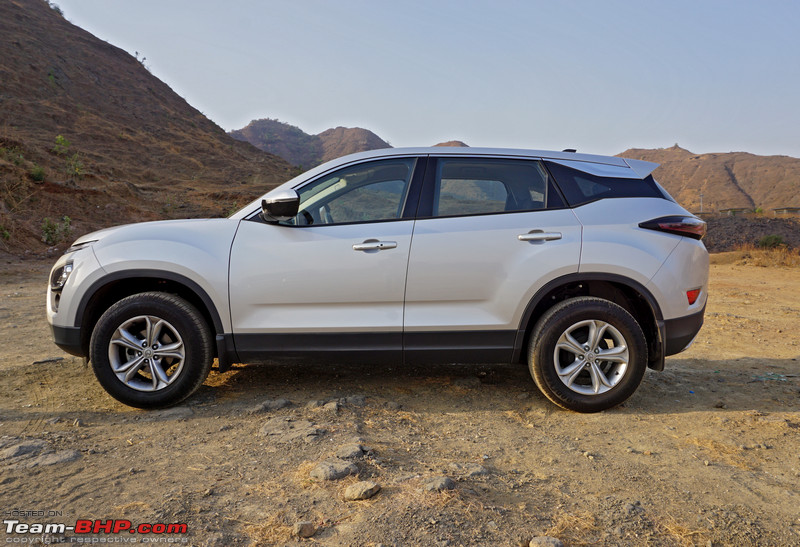 When Tata Motors introduced the Safari in '98, it was the first Indian car company to build a contemporary SUV. No other Indian manufacturer had even come close to designing such a vehicle. The erstwhile 3-door Sierra too, was quite innovative back in the day, as was the Sumo. All of these cars sure have enjoyed a fan following. Surprisingly then, Tata completely changed its direction & focused 100% on hatchbacks & sedans, abandoning the UV segments. Tata practically handed over the MUV market to Mahindra on a silver platter. Ignoring SUVs wasn't a good idea either because SUVs & Crossovers have become the no.1 segment worldwide. And they offer amazing profit margins too. You could say that Tata Motors bet on the wrong horse. Saying that the Harrier is an important car would be an understatement. For one, Tata is on a roll after generally positive customer reviews of the Hexa, Tiago, Tigor & Nexon. Some fun products as well in the JTP twins - cars like these prove that Tata has a soul. In terms of product development capability, Tata has made giant strides and is a completely different animal today, compared to the lazy & boring company we saw in the late 2000s. Then, the 15-20 lakh segment offers the best of both worlds = big volumes + fat profit margins (a rare combination). Just ask the Hyundai Creta & (earlier), the XUV500. Among the body-on-frames, there is the outdated Scorpio which still does ~4,000 cars / month! Thousands of customers each month are willing to pay big bucks for SUVs they love. In 2014, Tata finally decided that it will build a couple of new SUVs with the help of its subsidiary, Jaguar Land Rover. Tata Motors used Land Rover's D8 platform - which underpins the Discovery Sport - to create the Optimal Modular Efficient Global Advanced (OMEGA) Architecture, a monocoque for its new SUV, the Harrier. The D8 platform is a good start as one million SUVs based on this architecture have been sold worldwide. Trivia: early test mules of the Harrier were tested with a Land Rover body! Featuring Tata's Impact 2.0 design language, the Harrier looks radically different from any Tata car built before. And it's deadly handsome! This has certainly managed to cause a lot of excitement around it. When the Harrier was displayed at the '18 Auto Expo as the H5X Concept, it was the center of attraction. The production version looks equally stunning. On our test drives, it turned heads like you wouldn't believe. We'd stopped for breakfast at an open restaurant and when we were driving away, every person on every table was staring at our orange car. The Harrier has P-R-E-S-E-N-C-E. Built with extensive usage of advanced high strength steel, the Harrier feels robust & solid (Compass is better though). There is barely any flex in the metal and the bonnet + doors have a good deal of weight to them. The paint job is very good as well (but surprisingly, not excellent for this price point). What is disappointing is the fit and finish. Panel gaps at various places aren't even. Let alone cars like the Hyundai Creta, the Harrier does not even match some other Tata vehicles in this respect. Get this, the Hexa & Nexon felt "more sorted" than the Harrier. There is absolutely no doubt that Tata has rushed into the Harrier's launch. I’d much rather they’d have taken another 6 - 12 months and launched a completed car (if you are considering buying one, I recommend waiting for the 2020 or 2021 Harrier with all its rough edges ironed out). 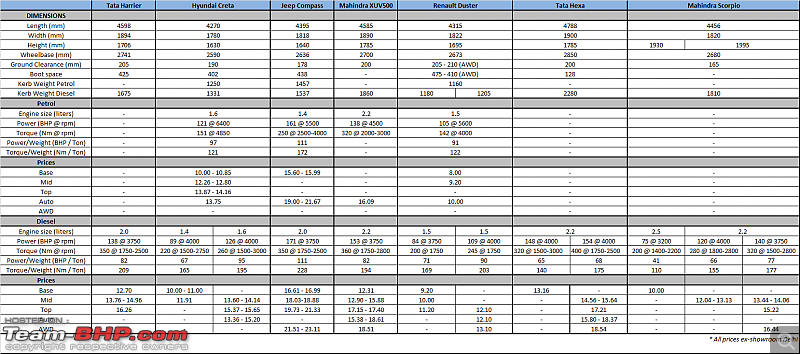 Measuring 4,598 mm in length, 1,894 mm in width and 1,706 mm in height, the Harrier is longer & wider than all other 5-seater rivals...and the 7-seater Mahindra XUV500! Its wheelbase of 2,741 mm is longer than that of the XUV500 as well. Unfortunately, Tata's willpower to stick to a diet remains shaky. The vehicle's kerb weight of 1,675 kg makes it heavier than all other monocoque 5-seater rivals. Coming to safety, the Harrier is equipped with dual front airbags, ABS + EBD, rear parking sensors, seatbelt reminders for the front seats and speed sensitive auto-door locking as standard. The top variant gets 6 airbags, ESP, ISOFIX child seat mounts and a reversing camera. We would have liked TPMS and front parking sensors to be standard at this price point though. While the Harrier has not been crash tested by independent entities like the NCAP, the Land Rover Discovery Sport has received a 5-star safety rating in the Euro NCAP crash test. Besides, in 2018, the smaller Tata Nexon got a 5-star safety rating from the Global NCAP too. We expect no less from the Harrier & hear that Tata's management has pushed for the topmost NCAP rating for this car. Tata is offering a standard warranty of 2 years / unlimited km, which can be extended to 4 years / 130,000 km. We strongly recommend this warranty extension as brand-new Tata cars are known to suffer niggles. Heck, both our test Harriers had multiple problems! We're disappointed that the warranty cannot be extended to 5 years as that's pretty much the industry standard now (some manufacturers offer coverage for up to 7 years!). Priced between Rs. 12.70 - 16.27 lakhs (ex-showroom, Delhi), the Harrier's pricing is reasonable for whats on offer. The pricing further shows Tata's confidence in its product and how the brand is slowly and steadily evolving (from the doldrums it was in a decade ago). There are more people speaking positively about Tata's cars (although there are a lot who still wouldn't consider the brand at all). That said, we wish that Tata had done an "XUV500" with the pricing. The Mahindra was priced so mouth-wateringly well that it created a shock in the segment. Mahindra actually held a lottery for customer allocations! What Mahindra did is make the XUV500 appealing even to those who wouldn't have ever considered a 15-lakh rupee Mahindra otherwise. That won't happen much with the Harrier. Those who were open to the Tata brand or sitting on the fence will buy the Harrier. But the pricing has not given the brand skeptics any reason to convert (unlike the XUV500 which was the first Mahindra for a LOT of families). Easily the best-looking launch of 2019! Drop-dead gorgeous looks will be a big draw for the Harrier. We've said it before & will say it again = Pratap Bose & his team have TASTE. Harrier is the first Tata car to feature the Impact 2.0 design language. Car has a good stance & strong road presence. The DRLs and headlamp clusters are uniquely placed. While the DRLs are on top, the headlamps are lower down on the bumper! 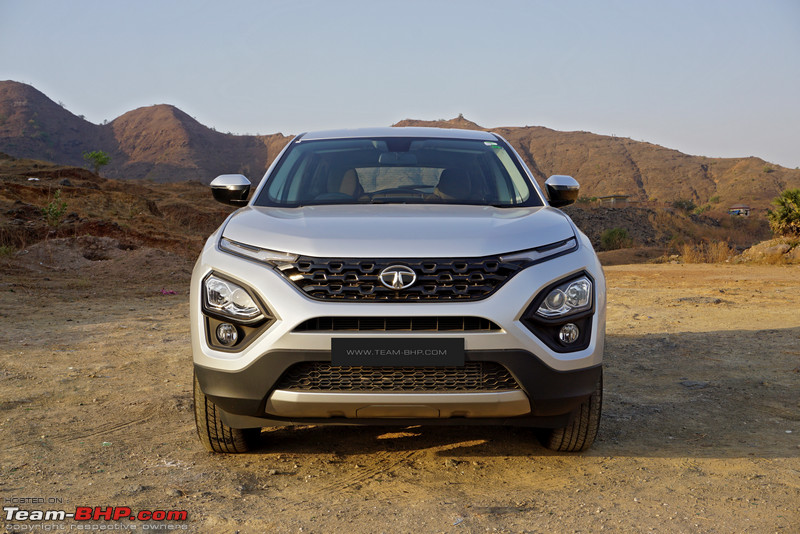 Rear end is classy. LED tail-lamps appear to stick out from the sides. Exhaust pipe is superbly concealed & requires a second look to spot (it's on the left). The car overall has a "Land Rover" vibe to it: 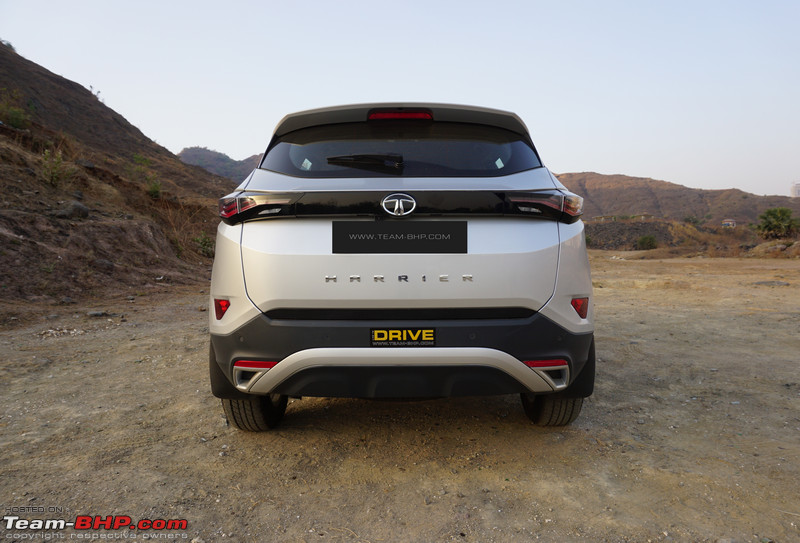 Viewed from the side, the Harrier's design is very well balanced. Looks contemporary & beefy. Thick black cladding on the sides and the bumpers hides the visual bulk & gives the impression of much higher ground clearance. Use of chrome is restricted to the door handles and the ubiquitous garnish on top of the windows. Front and rear overhangs are rather short. The Harrier's 2,741 mm wheelbase is the same as that of the Discovery Sport: 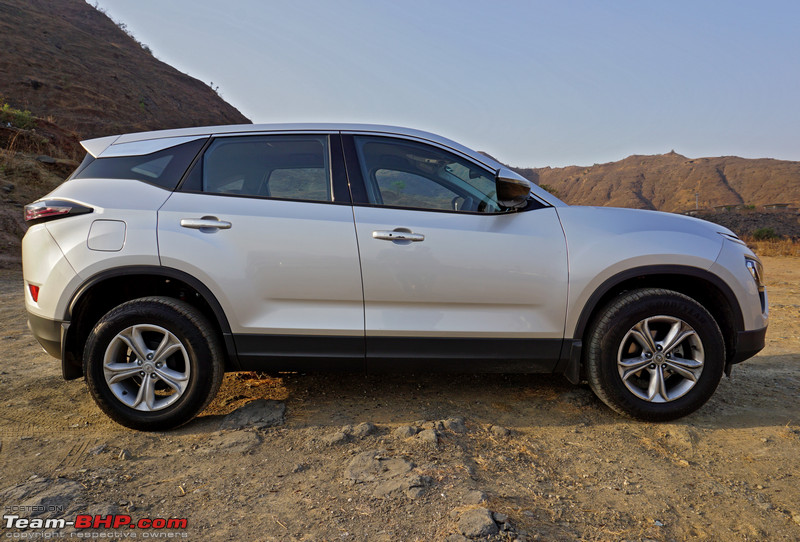 One of the best angles to view the Harrier from. If Tata can make a van good looking (Hexa), you can imagine how they went all out with an SUV. GTO had taken the orange Harrier to a social outing and parked it in a sea of Mercedes’, BMWs & Audis. Impressively, the Harrier didn’t look out of place in that group (an XUV500 or Creta surely would). The Tata looked just as premium. Want more proof? Check this image shared by BHPian JS Kwt: 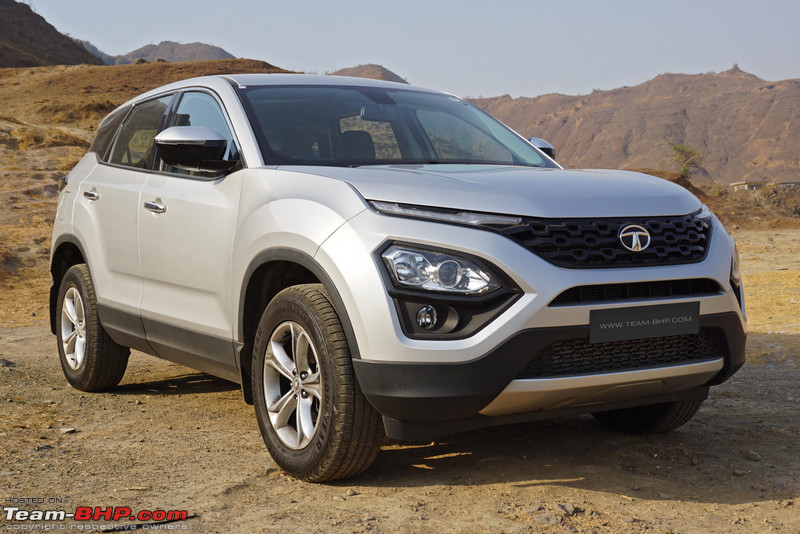 Flared wheel arches and a couple of creases on the sides gel well with the overall design, enhancing its muscular look: 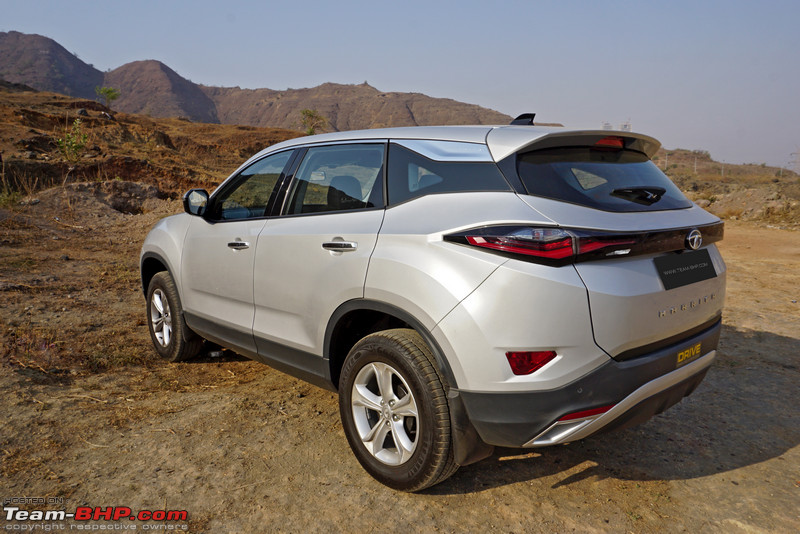 Slim LED DRLs sit just below the bonnet. Notice the stepped design: 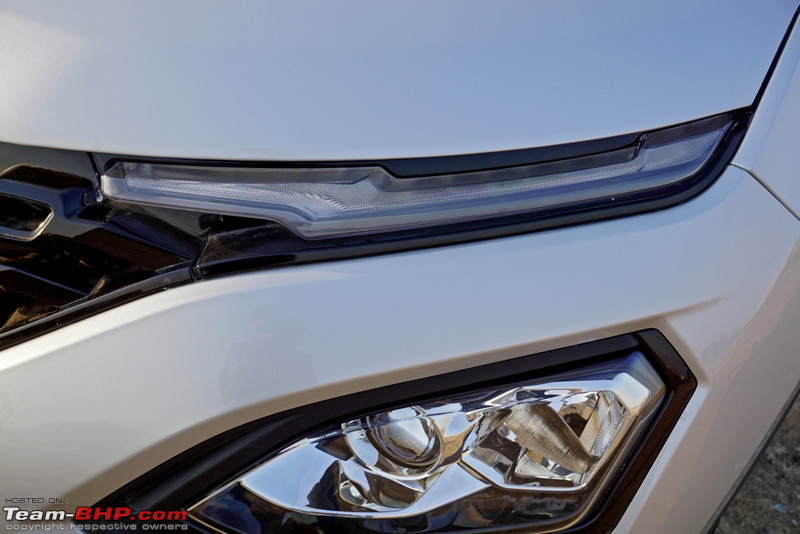 DRLs are bright and prominent, even during the day. They also serve as pilot lamps and dim a little when the headlights come on. The Harrier which we drove in December had DRLs with a bluish tinge. The cars we got in Bombay had proper white LEDs (which means these DRLs are of better quality):  They double up as turn-indicators! 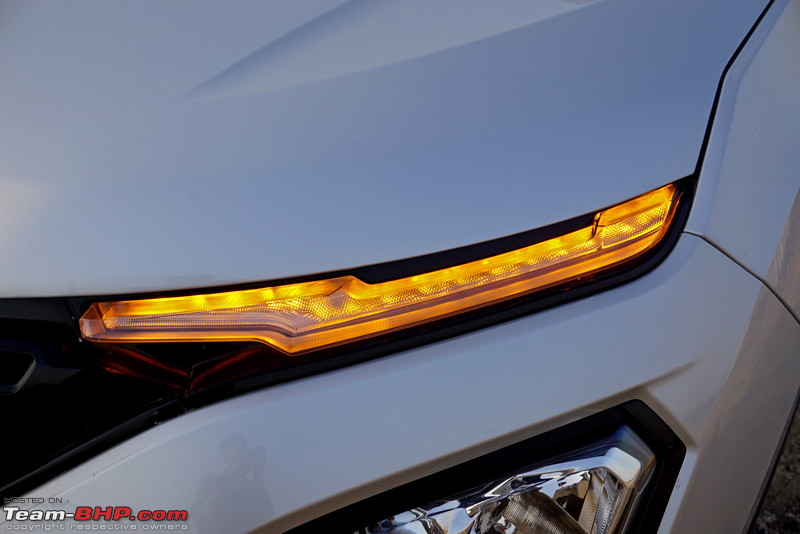 Headlamp clusters consist of Xenon HID projectors for the low beam and regular halogen units for the high beam. Funnily, the low beam is located on the inner side rather than the outer (where it usually is). We wish the headlamps used some "blackened" effect / highlights as there is way too much silver / chrome in them. Also, many BHPians are rightfully concerned that even a small frontal impact / bikers will damage the headlamps due to their unconventional placement. XM, XT and XZ variants get a follow-me-home function in which the DRLs and projectors come on when activated by a key fob button. Round foglamps are placed just below the headlamps. They are adequately bright and serve as cornering lamps as well: 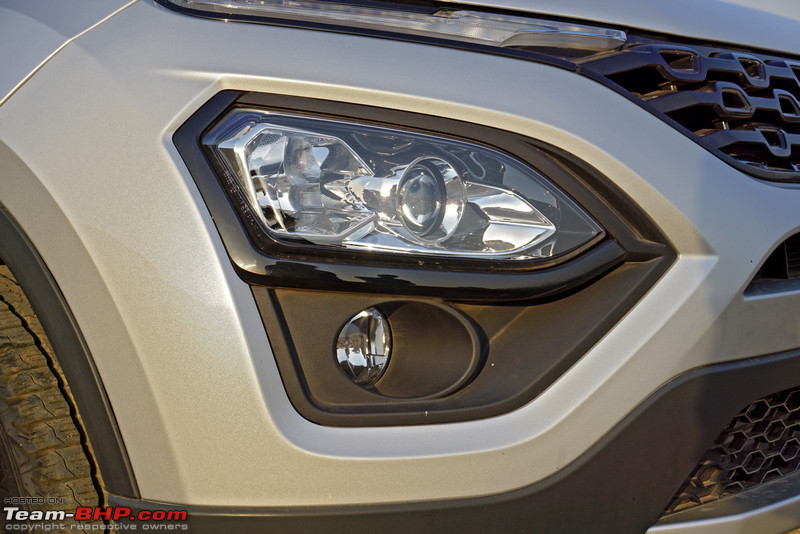 Headlight projectors sport sweet markings - a lion is engraved on the sides of both: 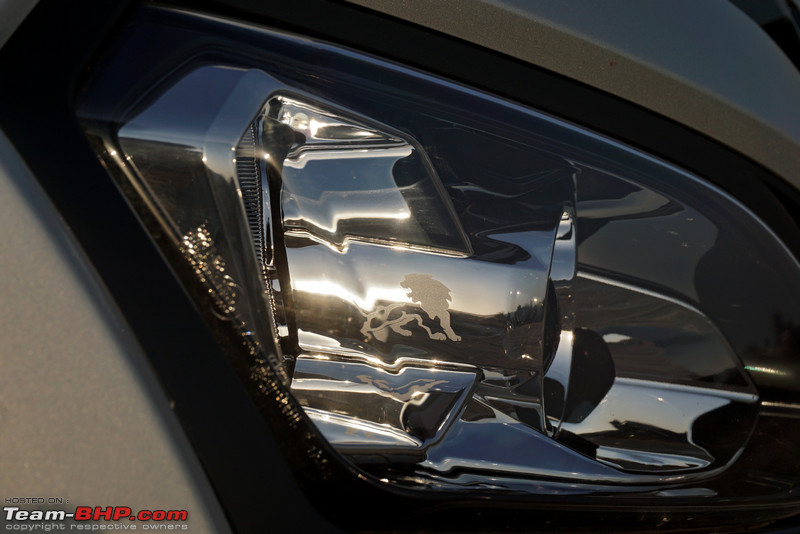 A look at all the lights in action:  Wide, glossy black grille has chunky trapezoidal blocks. One can see the condenser clearly through the big openings: 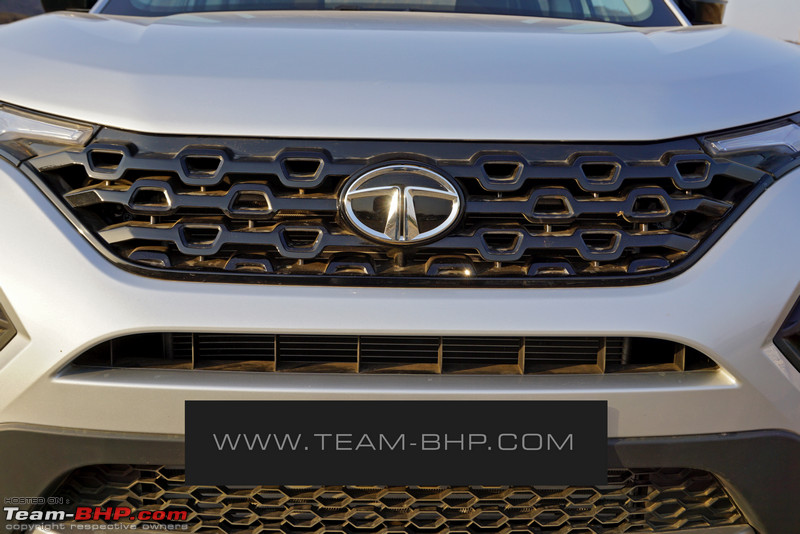 A glance at how the detailing and badge stick out of the grille: 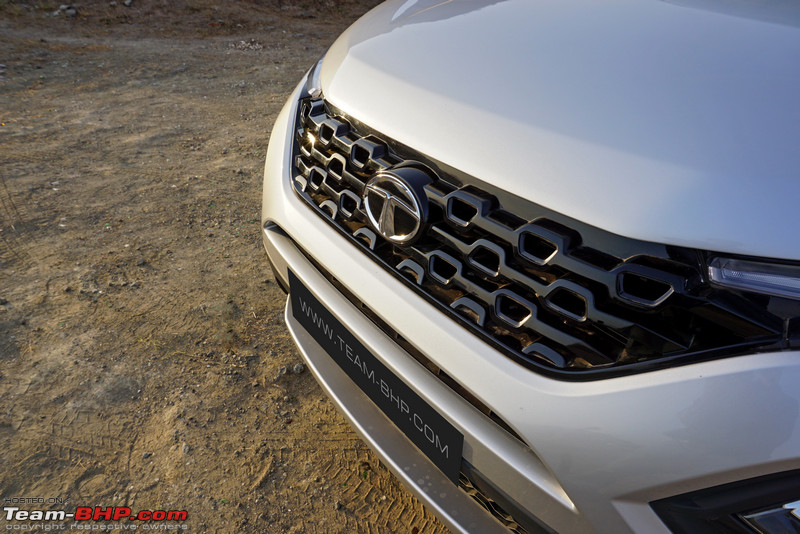 Dual-tone bumper incorporates a split air dam with vertical slats at the top and a honeycomb mesh grille at the bottom. Silver plastic skid plate adds to the SUV look, but it is obviously a fake. Like the Yaris & XUV300, we wish this car also got front parking sensors (due to its size & headlamp placement): 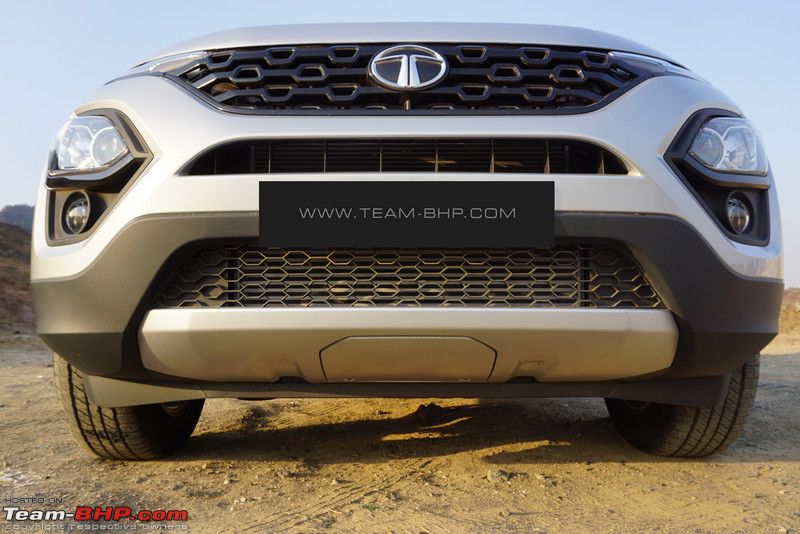 To access the towing point, the mid section of the skid plate needs to be unscrewed - tedious if you need to be pulled out from a sticky situation!! Don't miss the wind deflector: 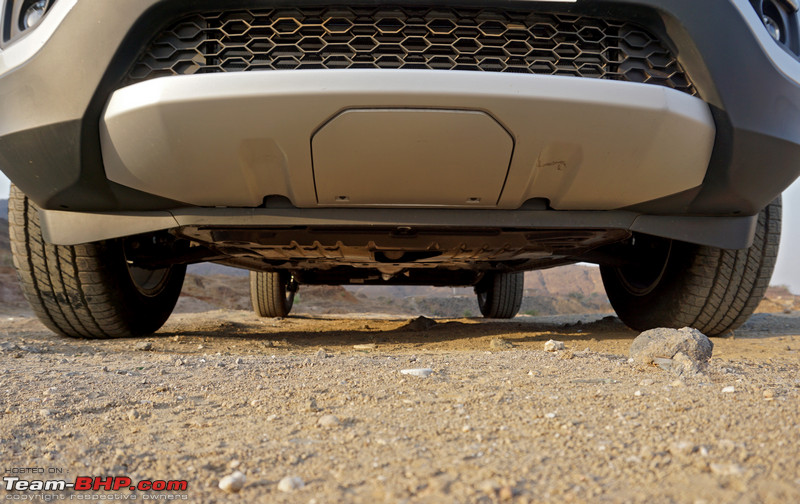 Go further in and you'll see there is a fair amount of underbody protection provided. 205 mm of ground clearance (unladen) is more than enough: 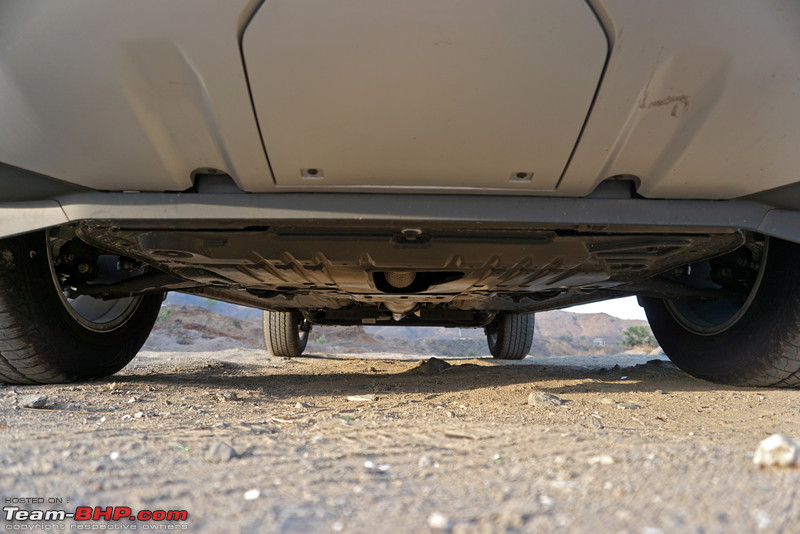 Long bonnet features a wide and largely flat central dome. Notice how the bonnet rises towards the outer sides: 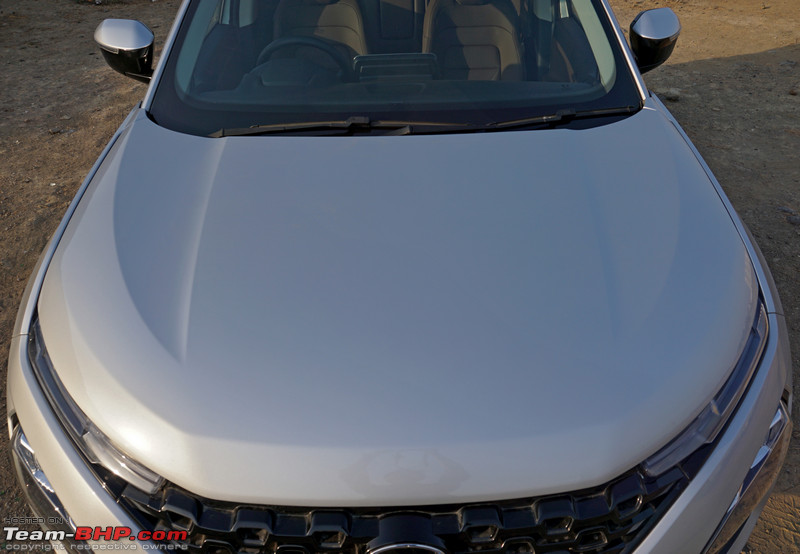 The Harrier is equipped with automatic rain-sensing wipers. The sensor is located in the center of the windshield: 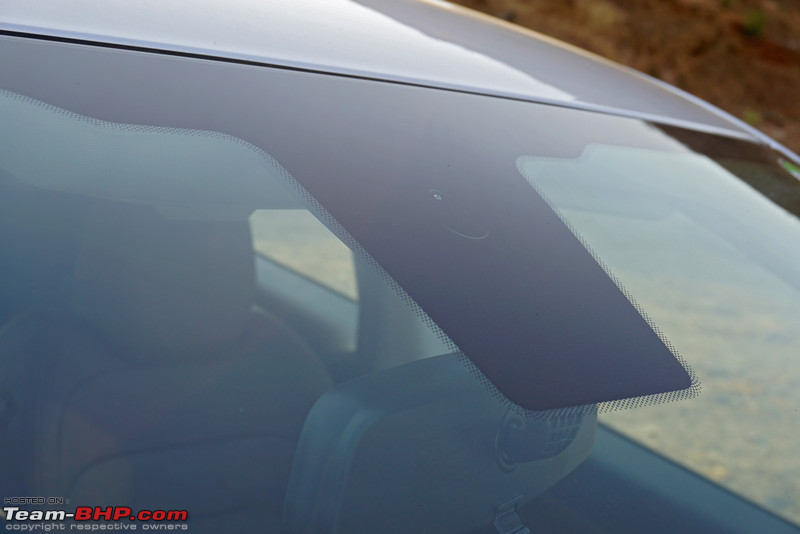 Wiper spindles are tucked away under the bonnet... 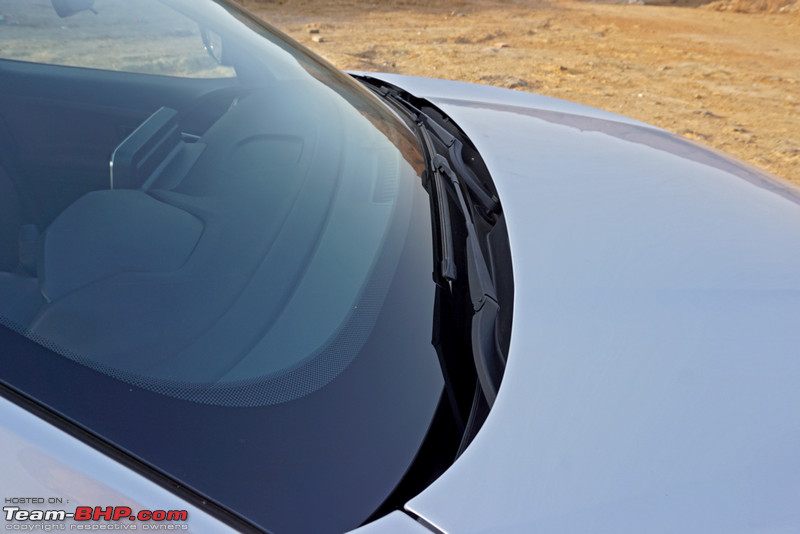 ...as are the washers. View the large size image and notice how crude they look: 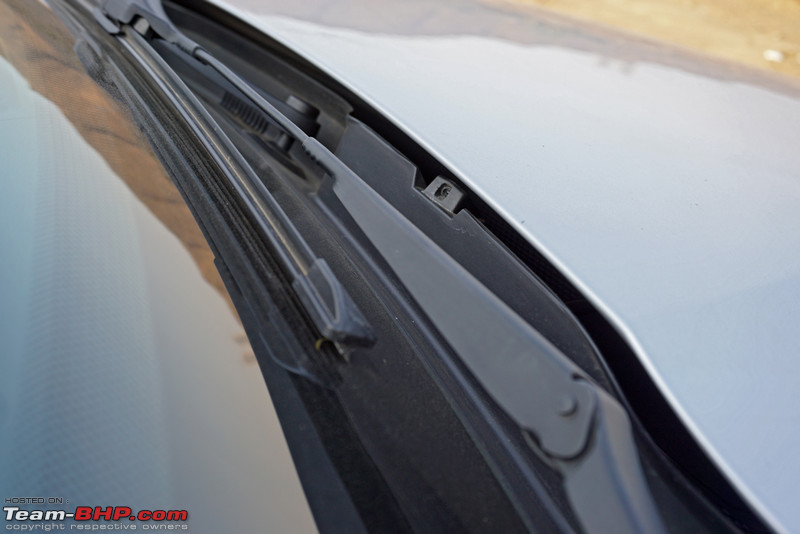 Both windshield washers squirt out effective sprays (rather than jets) of water. Big wipers offer a good sweep: 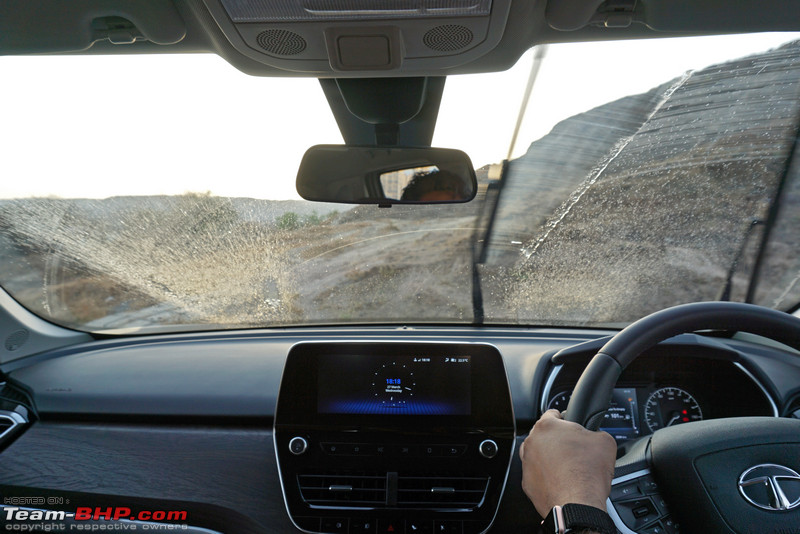 Dual-tone body colour + black ORVMs with integrated blinkers. Notice how the black portion has a step below the indicator: 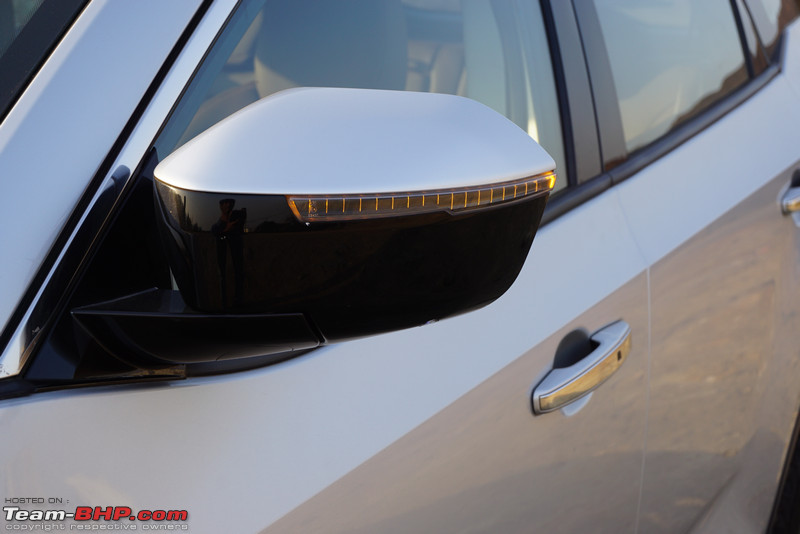 ORVMs house useful white puddle lamps underneath. They come on whenever you unlock the car: 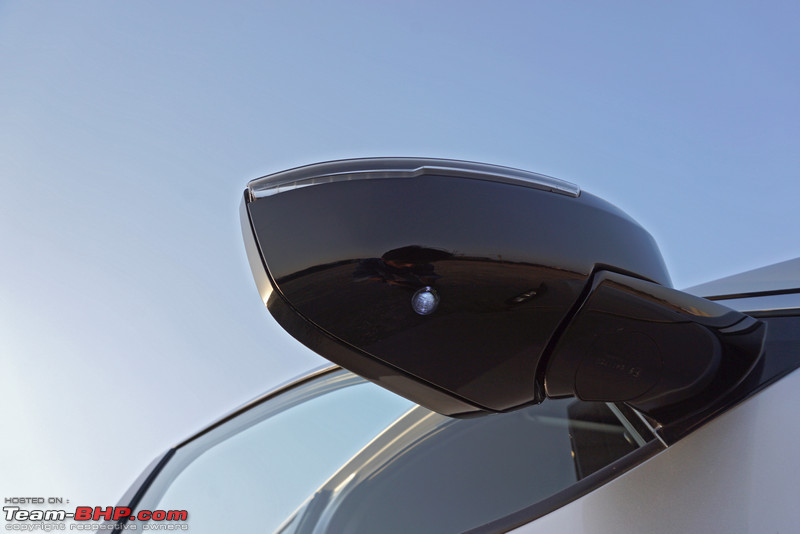 We get the feeling that Tata could have taken another 6 - 12 months to iron out the inconsistencies. Shut lines are not consistent at various places over the car. For instance, even around the doors, panel gaps are tight at some places... 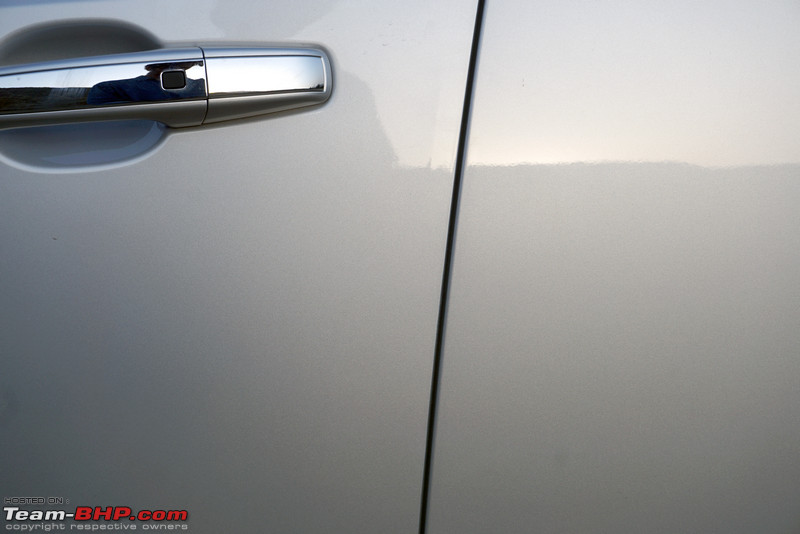 ...and wider in others. What's more, there were differences on the same body panels between our orange & silver media cars. That being said, the Feb manufactured cars we got in Bombay were better put together than the one we drove at the December media drive: 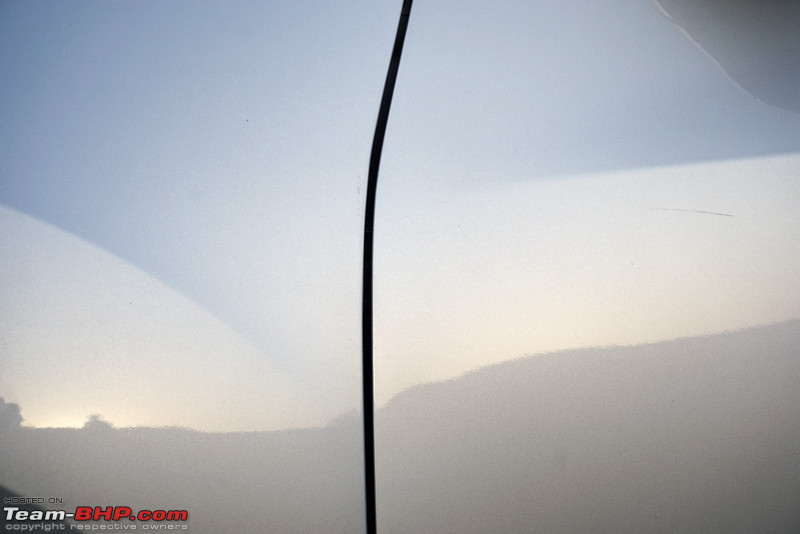 Gaps are at their widest around the bonnet: 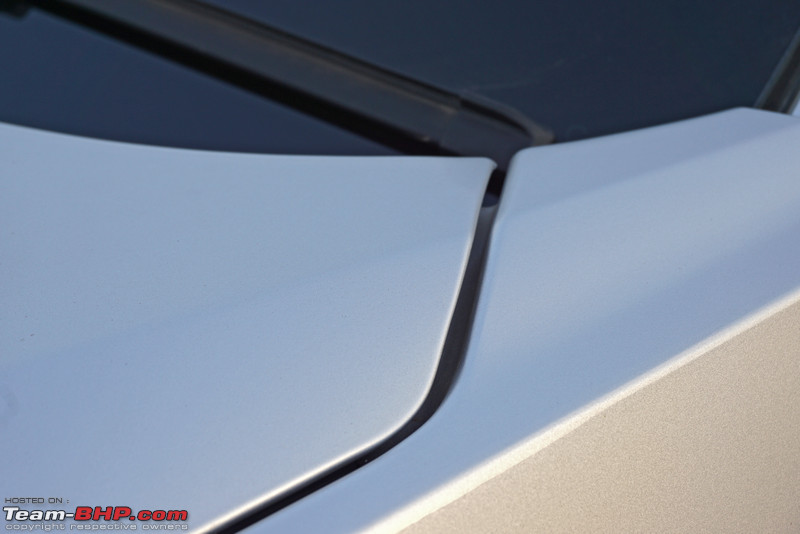 Door handles get classy chrome inserts on their sides. Driver + front passenger doors get request sensors. With the key fob in your pocket, simply touch the request sensor to lock / unlock the car: 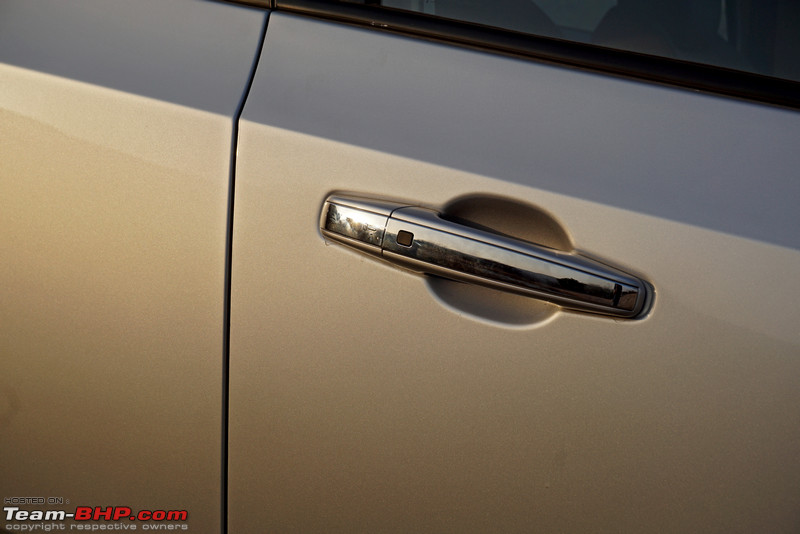 Keyhole can be accessed by removing the rear plastic piece of the driver's door handle. To remove the piece, insert the skeleton key into this hole: 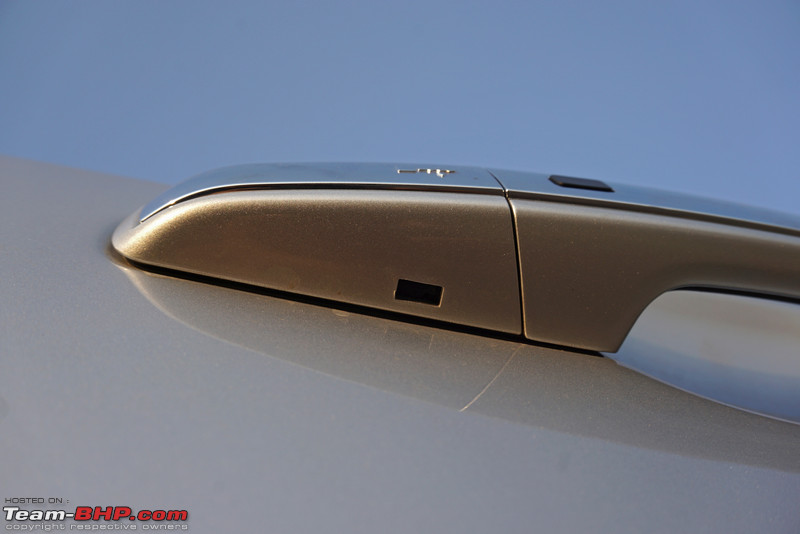 Roof slopes down towards the rear, while the window line rises. Chrome strip runs above the windows. B, C & D-pillars are blacked out: 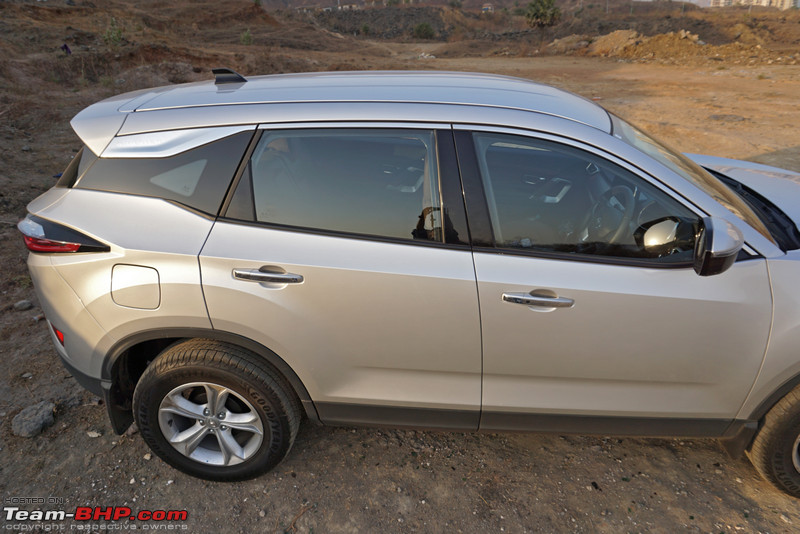 Harrier-badged chrome insert here is the only part of the design we don't like. This chrome panel looks very after-market'ish. Rear quarter glass area is too small to make any difference: 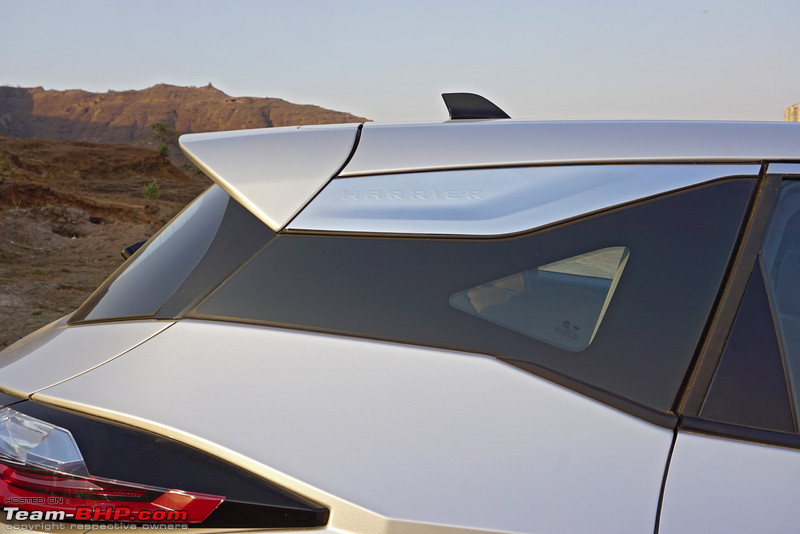 Another look at the chrome piece: 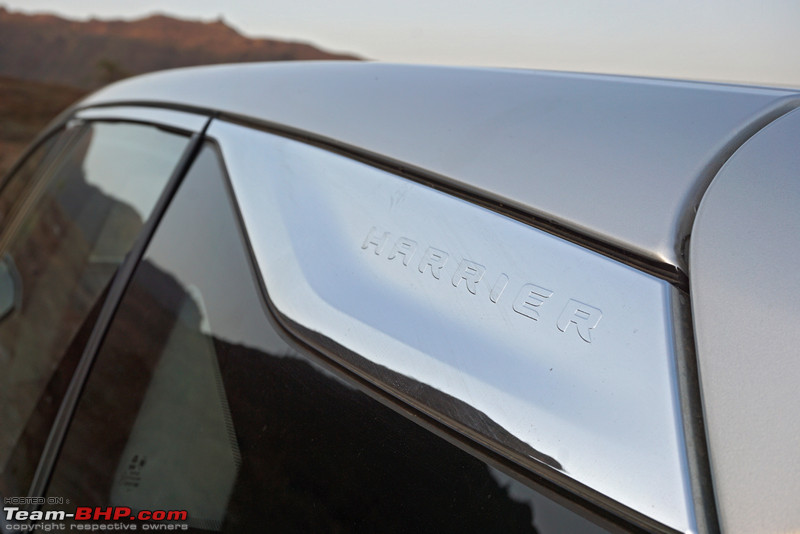 Black plastic cladding runs along the wheel arches: 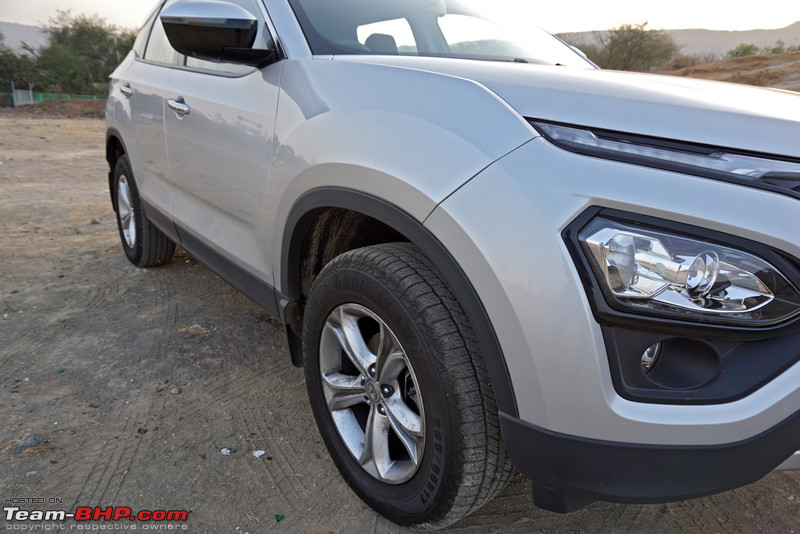 Subtle character line on the doors. Notice how the car's running board isn't visible from the side - it is covered up by the doors: 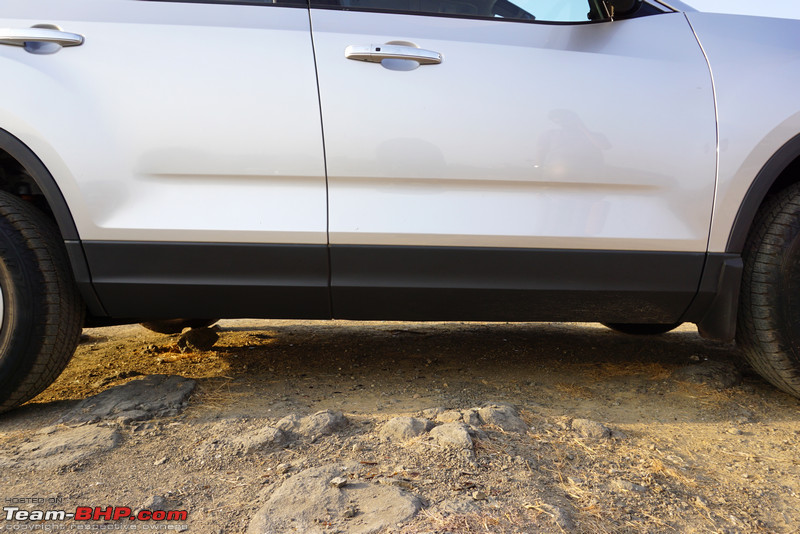 XT and XZ variants get 17" alloy wheels with 235/65 section Good Year Wrangler tyres. While some people said that the wheels look small, we think they are perfect. Plus, for SUVs on Indian roads, we'd any day pick smaller wheels + larger tyre profiles than the other way around. The alloy design is rather boring though and doesn't suit the sexy body at all. You could either get nicer rims from the after-market or, a cheaper solution, simply blacken parts of it (check BHPian Kalleo4's post here). XE and XM variants get 16" steel rims with 235/70 section tyres: 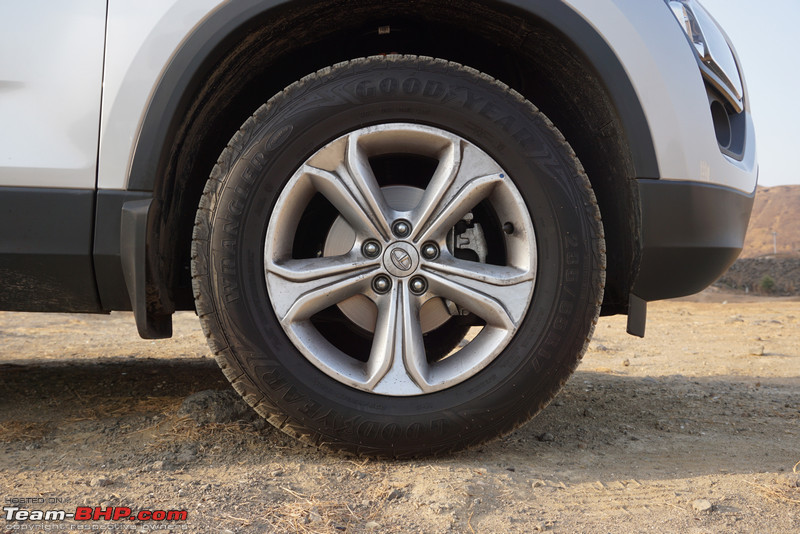 Considering that the Hexa gets disc brakes at the rear, we expected the same in the Harrier. Sadly, that's not the case (although we have no complaints with the car's braking ability): 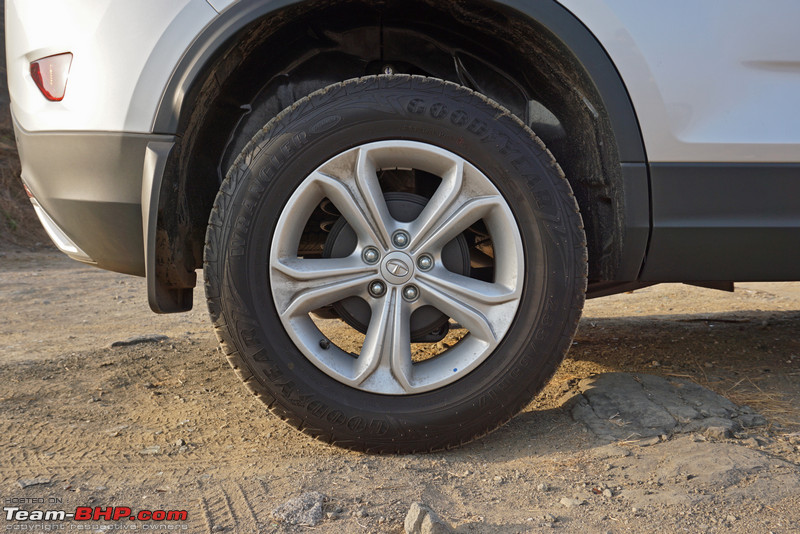 Roof is ribbed for superior rigidity. In a car with premium aspirations, a sunroof is conspicuous by its absence & will be missed by customers buying the top variant (Creta & XUV500 offer one). Roof rails aren't provided either; we quite like the design without them: 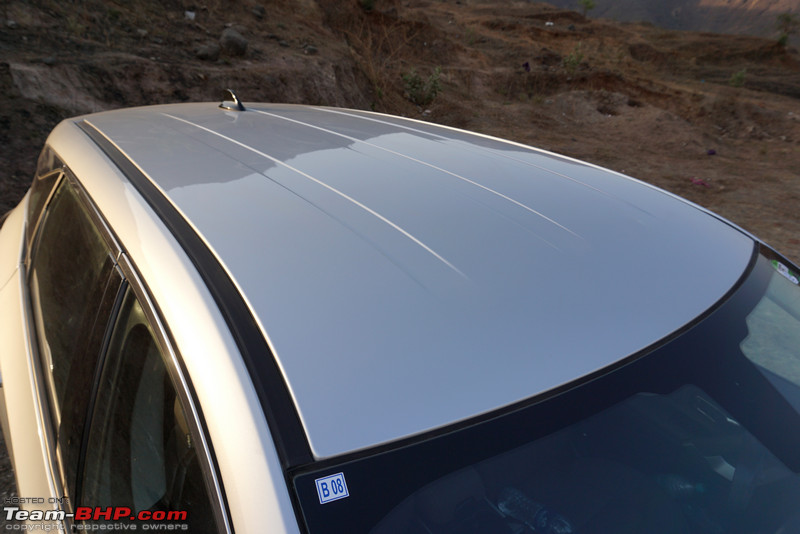 Shiny black sharkfin antenna sits towards the end of the roof section: 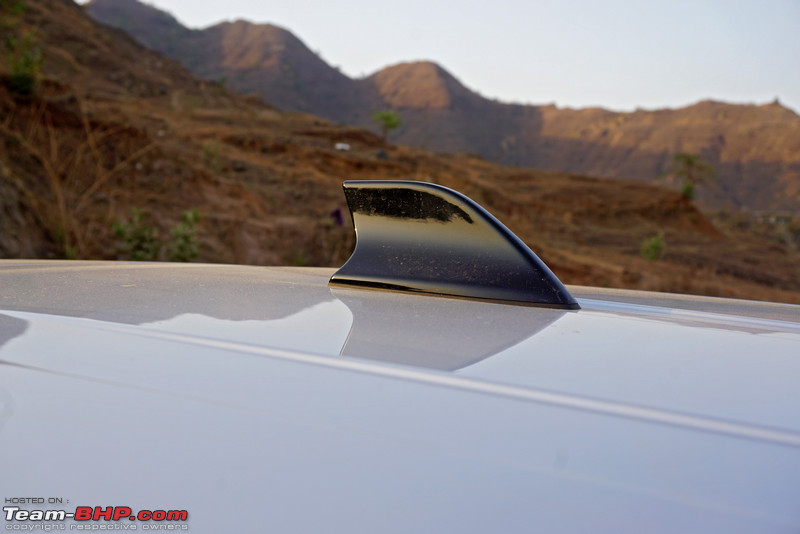 Tailgate gets a neatly integrated spoiler, which houses the LED HMSL:  An area where the fit is not perfect. The gap between the piano black plastic piece and the rear quarter glass is wider than that between the tailgate and body. Is out of alignment with the one on top & bottom too: 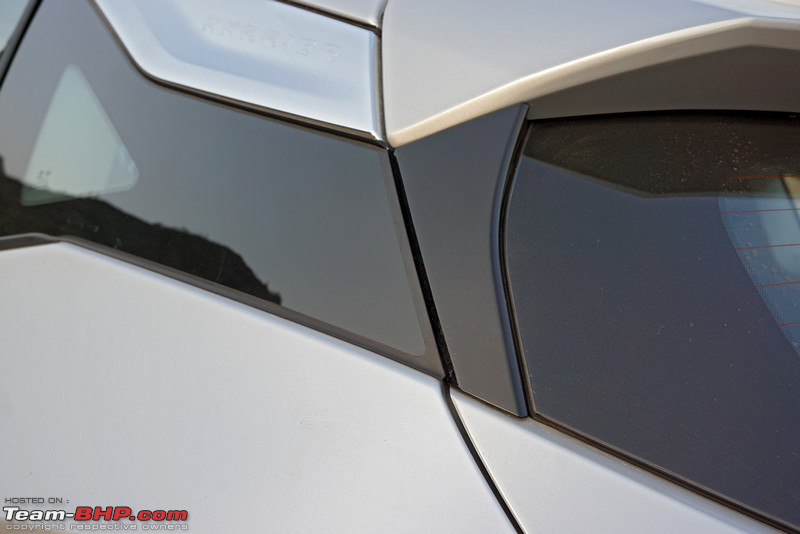 XM, XT and XZ variants get a rear washer/wiper. Washer is prominent and gets a thick black border. We feel it could have been better integrated (see how the Creta has a camoflaged washer here): 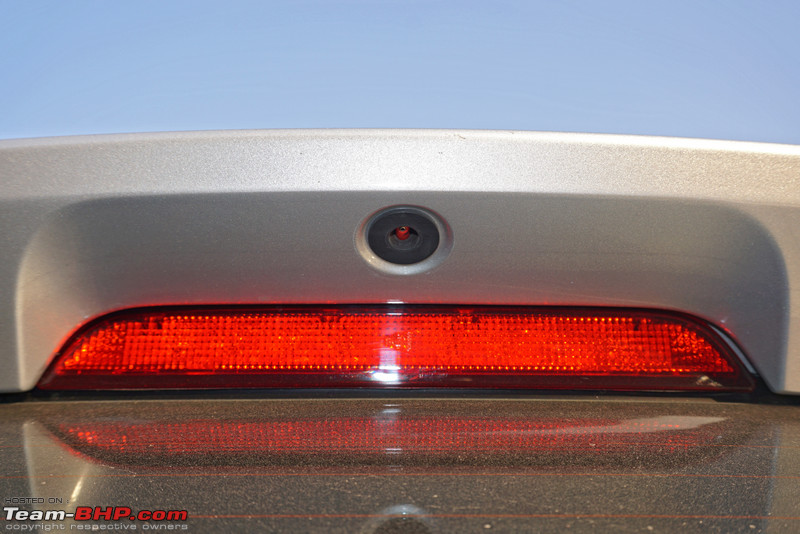 Split, slim & sexy tail-lamp clusters have glossy black outlines, a long LED strip for the pilot light and a short, slim stop lamp. The reversing lights sit on the tailgate section: 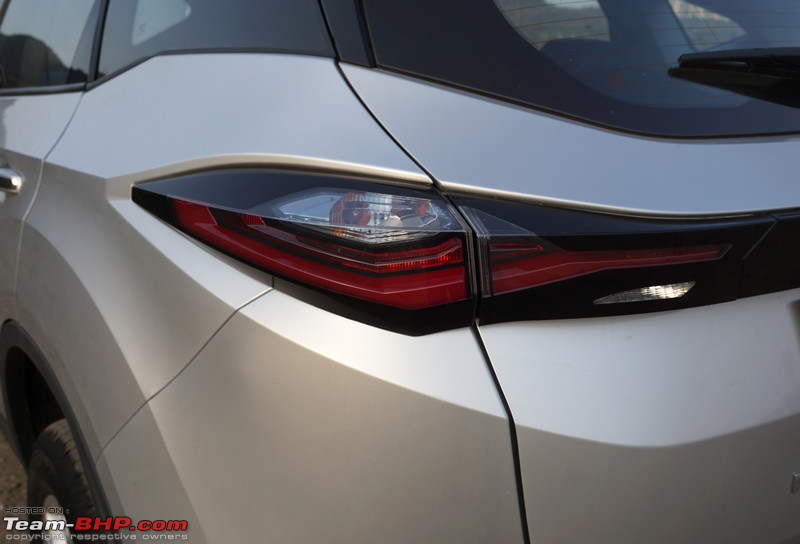 With all the lights in action. Looks fantastic at night. That said, BHPian S.MJet posted (and we concur) that the brake lights look rather small on the road - click here for an image: 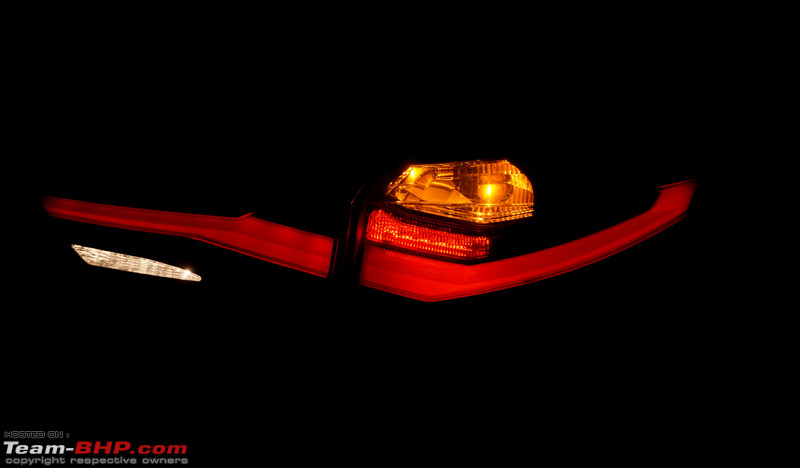 Strangely, the number plate does not get a recessed area on the tailgate. Rear windshield is too small in size. Glossy black strip runs between the two tail-lamp clusters (we love this & hate chrome strips). Use of chrome has been restricted to the "T" badge and prominent "Harrier" lettering low on the tailgate. H-A-R-R-I-E-R badging is similar to how we see it on Land Rovers & Range Rovers. Looks damn smart. Don't miss the black insert at the base of the tailgate which helps it merge with the rear bumper. Clean rear has no variant or engine badges: 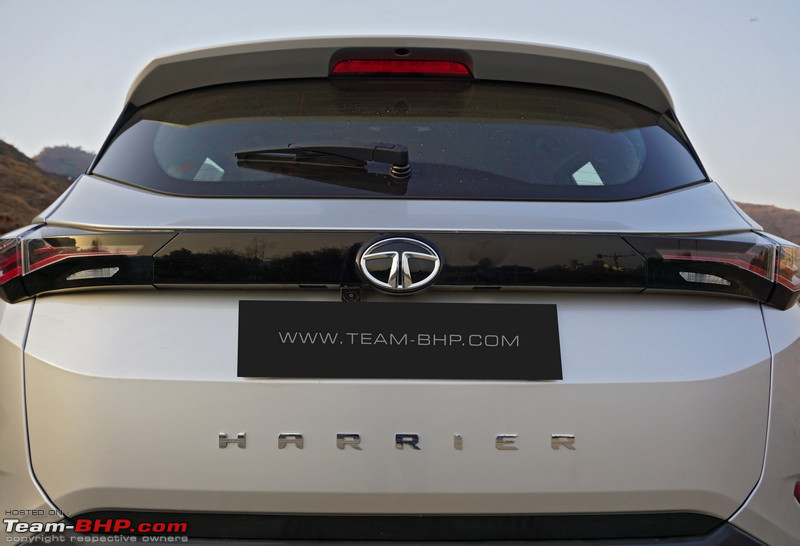 Rear windshield is short in height, which means only a short wiper can be accommodated. It leaves a large portion of the windshield unwiped. Short windshield also results in poor rearward visibility for the driver. A clear example of form over function: 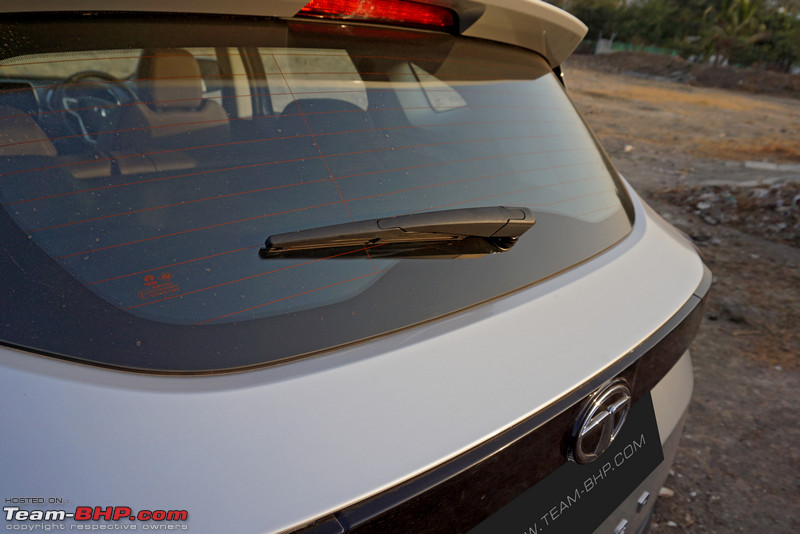 Another example of inconsistent fit & finish. The gap between the left tail-lamp and tailgate is narrower than that of the right tail-lamp!! 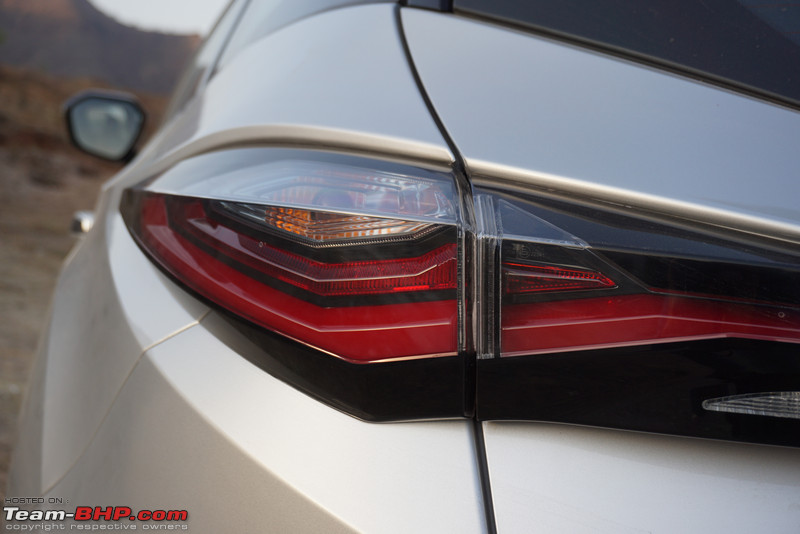 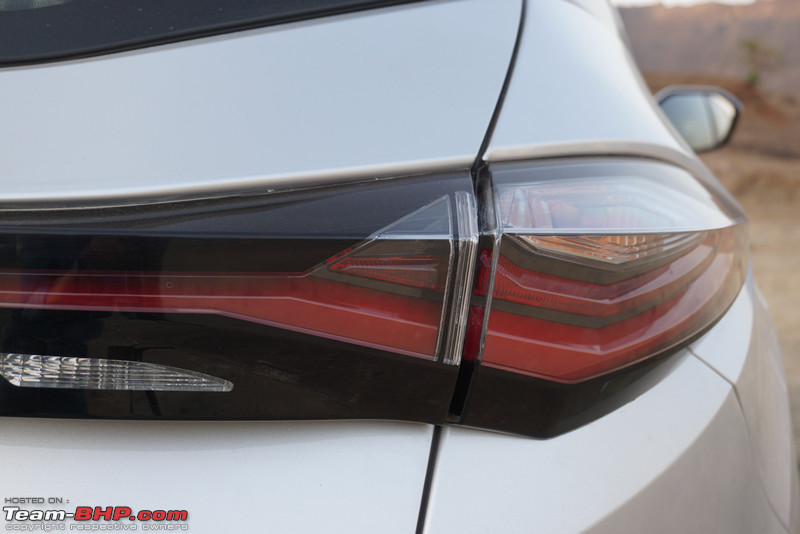 Lower edge of the glossy black strip should have been sitting flush with the tail-lamps: 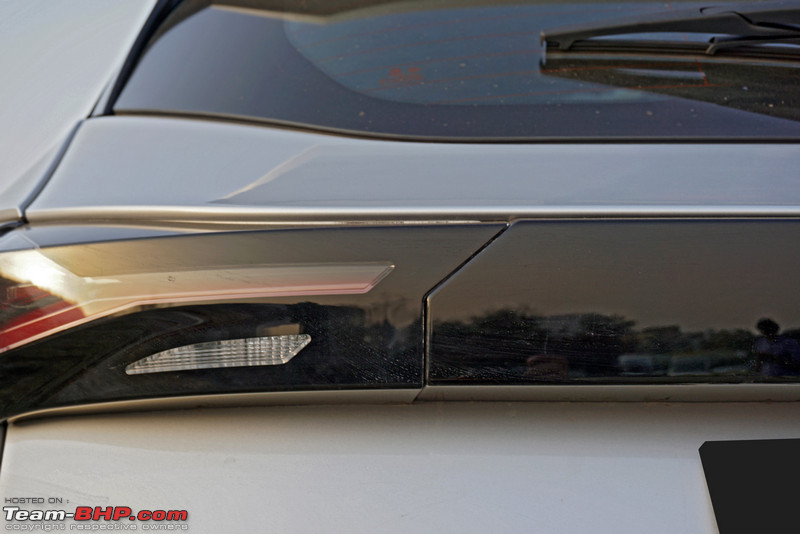 Small electromagnetic boot release sits below the "T" badge. It can take some time to locate it. Reverse camera (available in XT and XZ variants) is placed to the left. It's prominent when viewing the car from the rear; Tata should have concealed it better: 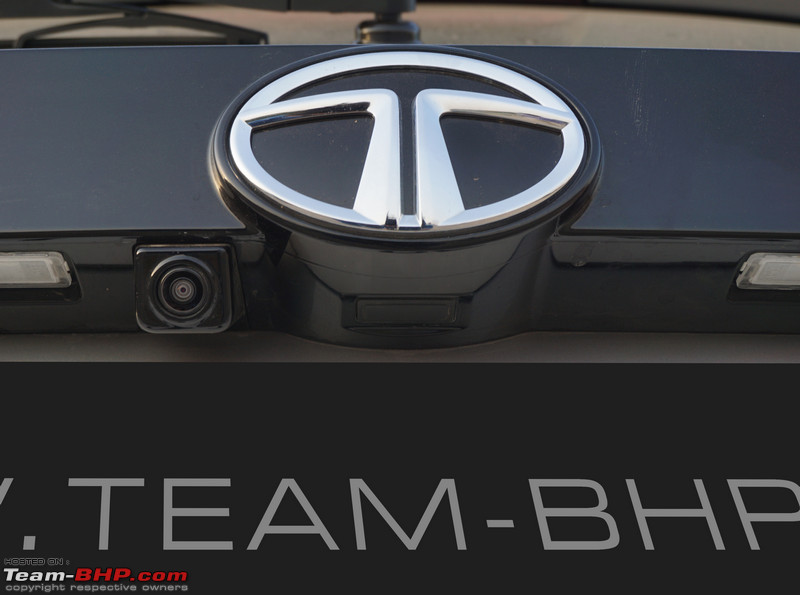 Four parking sensors are provided in the XM, XT and XZ variants. Along with the reversing camera, they prove vital while backing up the Harrier as the rearward visibility is poor: 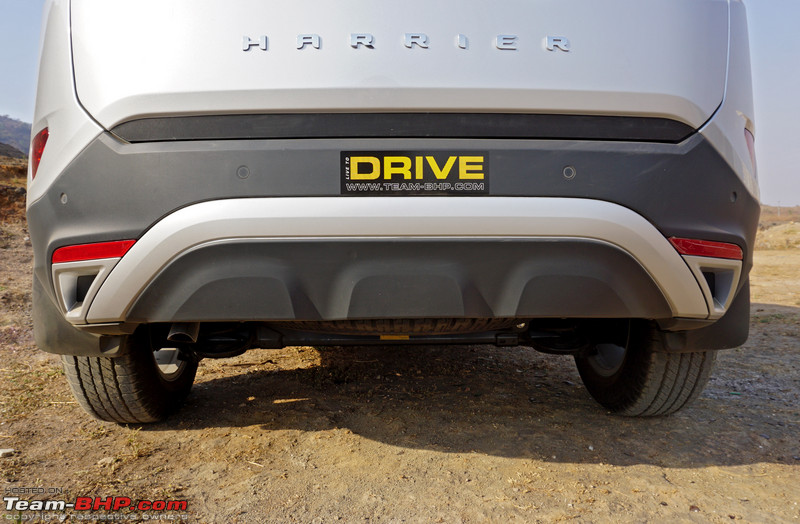 Like we've seen in many premium cars (Mercedes in particular), the Harrier gets fake exhaust vents (in silver) on both sides. That's for style and we sure aren't complaining. The actual tail-pipe is below. Note the slim reflectors on top of the faux exhaust vents: 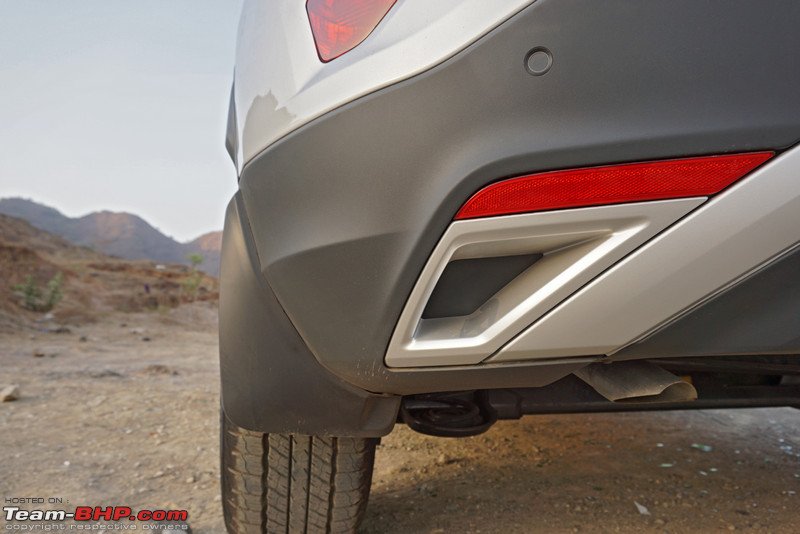 Small foglamps are located on the body-coloured area of the bumper (both sides). This part feels flimsy and when you press it, the light and bumper get separated! 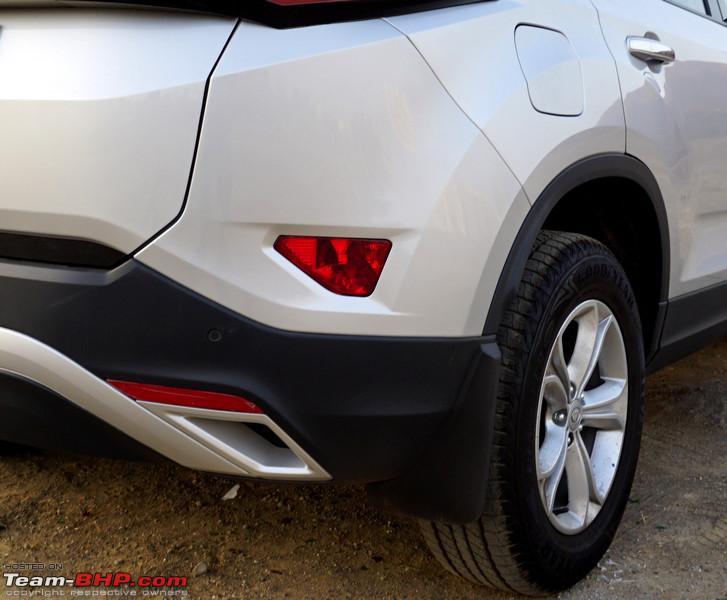 Semi-independent twist blade suspension with a panhard rod and coil springs at the rear. Spare is a 16" steel wheel with a 235/70 section tyre that is carried below the body: 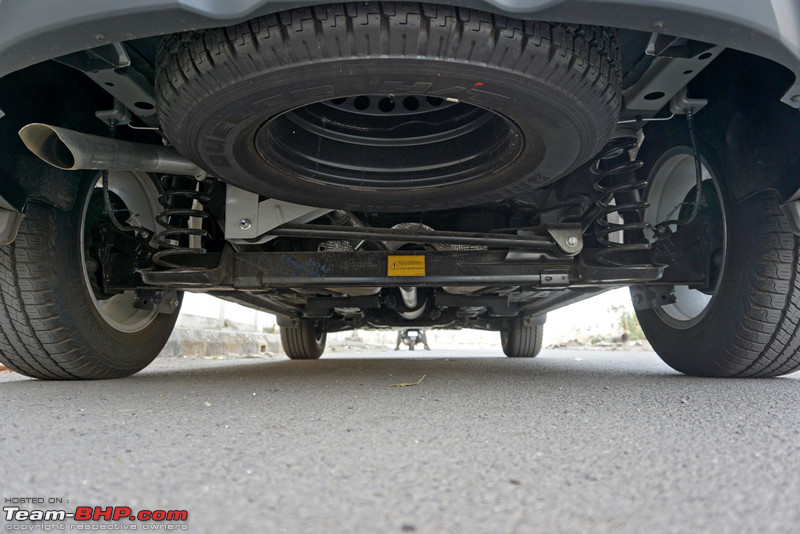 Side by side with Mahindra's success story. The Harrier is clearly the more futuristic and muscular looking. That said, the XUV500 is still a handsome car: 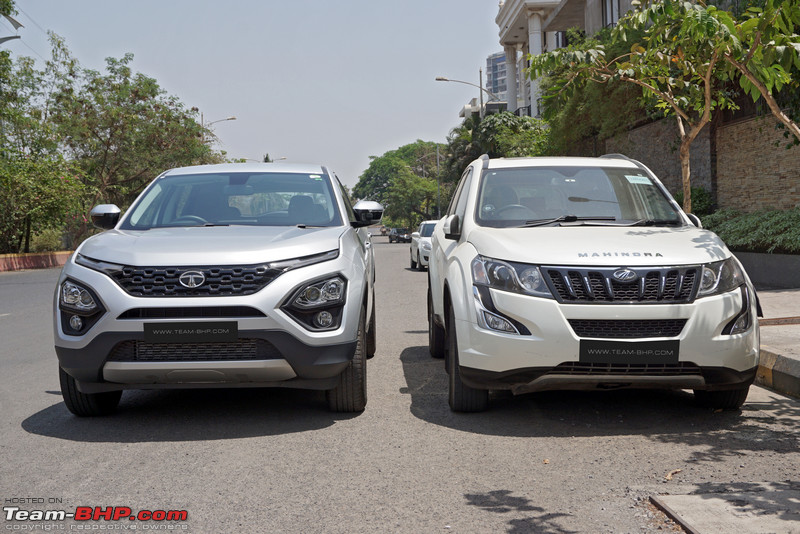 Both our homegrown manufacturers have come a long way indeed  . During our test-drive, a learned gent walked up and said "can you believe the kind of cars made in India today?". After experiencing the Harrier & XUV300 recently, we have to agree with him: . During our test-drive, a learned gent walked up and said "can you believe the kind of cars made in India today?". After experiencing the Harrier & XUV300 recently, we have to agree with him: The Harrier has fewer seats than the XUV500, but it is actually longer in length than the Mahindra: 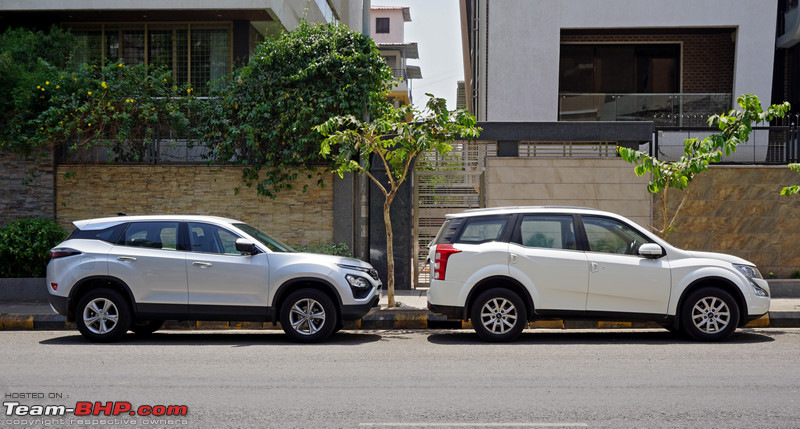 Last edited by Aditya : 21st May 2019 at 11:55. |
| |  (78)
Thanks (78)
Thanks
|
| The following 78 BHPians Thank Aditya for this useful post: | --gKrish--, 2himanshu, akshay81, arbaz906, AutoIndian, avisidhu, AYP, Bee, benbsb29, BlackPearl, ChiragM, Col Mehta, dailydriver, Dani7766, DeepBlueZen, digitalnirvana, Dr.AD, ecosport rules, espraveen, ganeshb, Gannu_1, graaja, GTO, Guna, hmansari, InControl, itsashishsharma, jailbird_fynix, JoseVijay, joshtronic, keroo1099, lemedico, Leoshashi, libranof1987, Lij, manjunag, Mevtec, MSAneesh, N33raj, nainan, nair, Nalin1, NPV, Obi-Wan, PapaKiloSierra9, phoenixash, PraNeel, PrasunBannerjee, R2D2, raghu13uk, RaghuVis, RavenAvi, Researcher, rohansachar, Roy.S, SaiSW, samaspire, shipnil, Simat, sparky@home, SpideyBoy, swiftnfurious, The Rationalist, theexperthand, The_Outsider!, Torino, TROOPER, TusharK, uday.ere, vaasu, Varun_HexaGuy, vb-saan, VeluM, vibbs, Vik0728, Vikram Arya, Xaos636, X_T_A Rose |
| | #4 |
| Team-BHP Support  | Interior - Front  The front doors open & shut in a triple-stage action. As mentioned earlier, they have a fair amount of weight to them. They feel robust, although there is no satisfying "thud" when you shut them. The doors open wide enough and the running board is not excessively thick, especially for a big SUV. The floor of the car is at a comfortable height, while the roof is on the higher side. Thus, it's very easy to step in and out. GTO's 75-year old Mom had no issue getting in. On the inside, the Harrier offers sufficient legroom & headroom at the front. The front windshield is large, although the roofline slopes downwards and I found the rear windshield to be on the smaller side. Still, the side windows are sizeable and there is enough light entering the cabin. Cabins of Tata cars have become very classy looking over the years & the Harrier is no different. The dashboard gets oakwood finish (fake wood) paneling which looks terrific! You won't know its fake until you touch it. The seats get perforated oak brown upholstery, which we didn't like at first, but did later once we got used to the colour. Coming to the interior quality, for a car that costs close to 20 lakhs OTR, it is good in some areas, acceptable in others and cheap in a few. No owner is likely to complain & equally, no owner is likely to brag about it either. We have no grouses here, yet will add that after seeing the Hexa / Nexon / Tiago (at their respective price points), we expected more from the Harrier. The dashboard’s styling is classy! Very European-car like. It has a black theme with faux wood and silver inserts, while piano black has been used on the center fascia and air-con vents. While the dashboard has an anti-reflective Nappa Grain top layer with soft touch plastic (which you will see often), the lower part features hard and cheaper material (which you'll rarely see or touch). The carpets are black and will do well to conceal any signs of soiling. Ergonomically, the cabin has some flaws and not all controls are easy to use. The feel, quality and finish of most of the buttons / switches are good:  Nice & high driving position. Shorter folk will need to crank the seat up as they'll find the dash to be high. This is one of the rare cars in which you can see the contours of the muscular bonnet while driving - many people will appreciate this:  Leather-wrapped steering wheel with classy dark silver inserts and perforated detailing is really nice & chunky. It is superbly thick and has a great design too. The steering has a bit of a deep dish effect to it, along with contours for your thumbs. However, the plastic used on the bulbous horn pad is cheap! Tata shouldn't cut corners in an area that is quite literally in the customer's face. The horn is also difficult to reach and hard to press, especially for those with small fingers:  Buttons for the infotainment system, telephony and voice commands are placed on the left spoke. Useful mute function has been provided (long press to mute). Cruise control and MID buttons are placed on the right. The "down" button to scroll through the MID was getting stuck at times on our test car:  A closer look at the sweet perforated detailing on the steering:  Zooming in to show the neat stitch pattern on the leather:  Steering has rake & reach adjustment. The reach adjustment has fantastic range. It is one of the few cars in which the steering is super easy to access for those with a laidback driving position (e.g. GTO & Vid6639). Reach-adjustable steering greatly contributes to the 'perfect' driving position:  Many BHPians complained of the center console fouling with their left leg while driving, so be absolutely sure to spend time in the driver’s seat before signing on the cheque. Me, GTO & Vid6639 did NOT face any issue. However, Rudra Sen & Blackwasp did have a problem. So again, check it out yourself:  Engine start button gets a chrome ring. If you press the button without pressing the clutch, an orange light glows ("accessory" mode). Press it once again and a green light comes on ("ignition on" mode). When the engine is running, the green light stays on:  Instrument cluster consists of an analogue speedometer, a digital tachometer and a 7" TFT MID. The digital area has excellent quality graphics! The entire cluster should have been a size or two bigger though. Many of you will find it small (we've noticed this in other Tata cars too). While the digital tachometer looks really cool, the markings (2,000, 2,500, 3,000) are a dark grey that merge with the black. Makes it hard to tell the exact rpm level during the day. A digital engine temperature gauge has been provided at the base:  Here's a look at the instrument cluster on startup. Speedometer and tachometer do a clean sweep. Redline starts at 4,000 rpm: 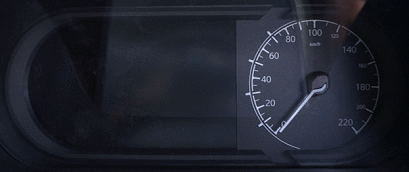 MID has a digital fuel gauge, two trip meters with average fuel consumption + driving time + average speed (individual readings for each trip meter), instant fuel economy (graphical bar), distance to empty, time & outside temperature. Gimmicky power and torque meters have been provided - these do have novelty value:  MID warns you if the fuel level is low or if the driver / front passenger hasn't buckled up. After approximately 3 hours of starting the engine and 2.5 hours of continuous driving, a prompt came up on the MID telling me to "take a break". Pretty cool how features trickle down from the high-end cars; we'd first seen this "take a break" suggestion in the Mercedes E-Class:  MID will warn you if a door or the tailgate has been left open. If one of the doors and the tailgate are open together, the door is shown as opened, with the tailgate highlighted in red. We respect this kind of attention-to-detail. There is no warning for the bonnet though & IMHO it's about time manufacturers start adding the same. If you try to start the car without the key in it, the MID will display a warning:  Thick stalks feel durable, but they aren't well-finished. Look closely and you'll see the unevenly finished borders. Auto headlamps and auto rain-sensing wipers work like a charm. A lane change indicator is present. Headlamp leveler is smartly placed on the stalk itself. Like in other Tatas, the DRLs can be turned OFF / ON by moving the light switch to the parking lamp position & back to the off position, twice in quick succession:  Side air-con vents get piano black housings and tasteful silver borders. These have a very German car-like premium feel when you adjust the direction. There is no air volume controller provided. You can shut the rightmost vent by pushing the flow direction controller to the extreme right, although there is a little air still coming out (similarly, the left one can be pushed all the way to the left):  Bonnet release looks cheap for a car that costs as much as the Harrier. That said, it is robust and feels long-lasting:  OBD port is located on the left side of the driver's footwell:  Yep, it gets a plastic cover:  Doorpads are large with softer plastic used at the top, and hard material lower. Colour is sensibly black. The door handle + window controls should have been placed further ahead on the doorpad. Right now, they are too close to the driver. So, you cannot ergonomically operate the power windows - you have to bend your elbow. Shorter drivers or those of a medium height are going to find the placement even worse. All doors get red warning lights at the bottom:  Top of the doorpad is about 3" wide. Taller drivers can rest their arms here, if they wish to (ditto for all the passengers too): 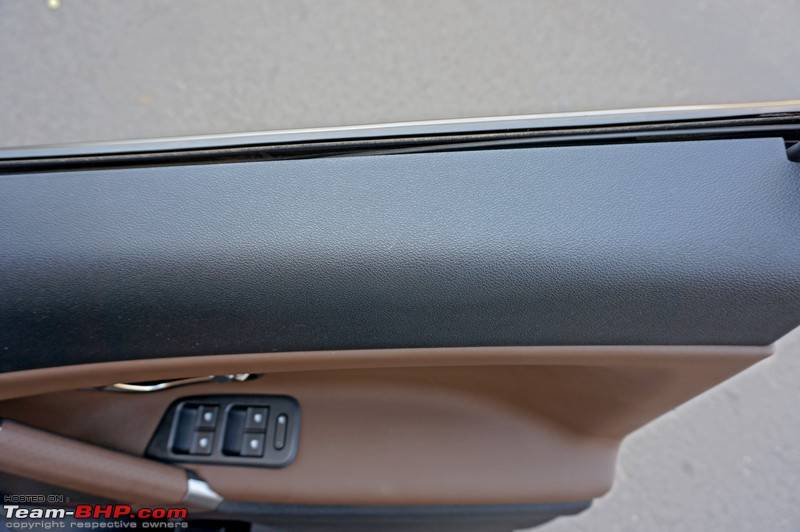 Doors are thick and so are the doorpads:  Smart-looking door handles. If the driver wants to open his door, he needs to just pull on the door handle (without using the unlock knob). There is no dedicated central locking / unlocking button. The lock / unlock knob on the door handle takes care of the central locking:  Impressive! Leather upholstery on the grab handles has perforated detailing:  The armrest and large area above it get soft leather:  Power window console is lifted from other Tata cars. Red light on the 'window lock' button appears when all passenger windows are unlocked & can be operated!! Weird, it should have been the other way around. Driver's window gets auto up & down, but you have to long-press to activate that (it's not one-touch). The windows further have an 'extended operation' feature wherein, you can roll them for a while even after the car's engine has been switched off. Useful to close any window that's been left open:  Rotary ORVM adjuster is located on the A-pillar. ORVMs can be retracted electrically and auto-fold on lock / unlock as well:  Door pockets are big and can hold two 1L bottles easily. You could even fit in a smaller 3rd bottle. There is a gap on the side of the topmost partition (maybe to hold a magazine?). The lowest slot is marked for an umbrella. The door pockets have sharp edges that could hurt your finger. Rather unfinished, we say:  Door sills aren't too wide, which means lesser effort to move your feet in & out of the car. No scuff plates provided by Tata:  The seats are draped in Benecke-Kaliko dark brown upholstery. The seats offer very good bolstering. Anyone who is taller than average will find the under-thigh support to be short though, as the seat base tapers off at the front (GTO & Vid6639 both felt it). On the other hand, those with a weak back will be pleased with the adjustable lumbar support. The seats are wide enough to accommodate larger users. Headroom is healthy - in the passenger seat, I had ~4 inches to spare:  Sturdy levers to recline the seat and adjust its height:  Solid metal lever for the seat's fore & aft movement:  Driver's seat gets lumbar adjustment which brings A+ back support. Those with a weak back and long distance drivers will appreciate it: 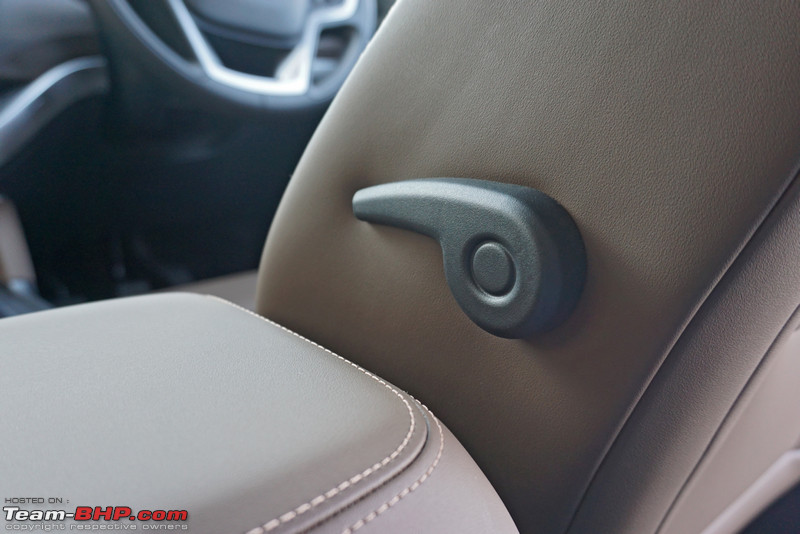 For such a big car, the fore & aft adjustment appears to be intentionally restricted to boost rear seat legroom. At 5'10", GTO was driving with the seat all the way behind. 6 footers might just about fit in, but if you are super tall, you will feel restricted:  Height adjustment range is healthy. Short or tall, no one will complain:  The leather upholstery is well stitched and the quality of material is satisfactory. Notice the perforated design pattern:  Center armrest has a soft leather-wrapped surface. However, the armrest isn't adjustable and we felt it was placed too far behind. 80% of drivers will find it useless:  Seatbelts aren't adjustable for height, which is surprising since the Hexa and cheaper Nexon get adjustable units. Still, they are placed at a comfortable height for most users. Notice the rough edges in the seatbelt slot on the B-pillar: 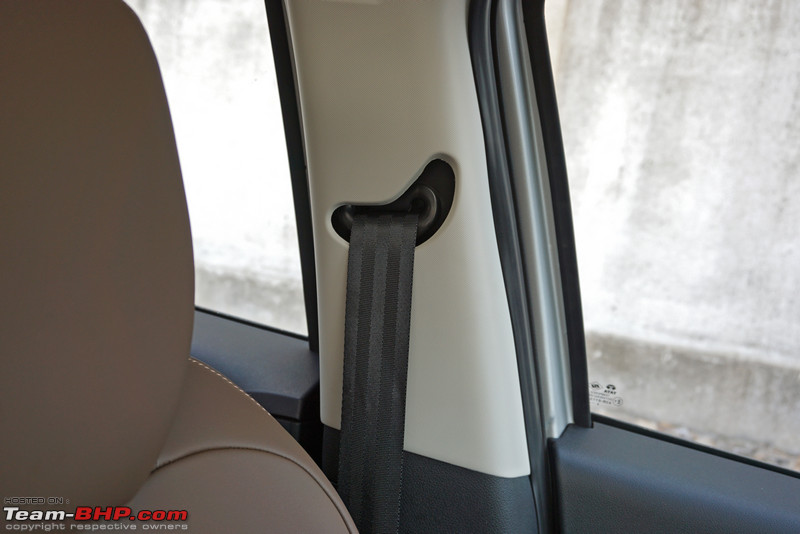 Front seats are lined with carpeting to hide the ugly mechanical bits below:  Narrow footwell is poorly designed. We find it strange that Tata manages to get its footwells so wrong (e.g. Hexa too). The pedal positioning is bad too. Some drivers' shoes will rub against the brake pedal while operating the clutch (I complained as did Blackwasp, GTO didn't). Dead pedal has been provided, but it's small and stupidly placed:  Very little space between the footwell and clutch pedal which causes...  ... this problem. Every time you rest your foot on the dead pedal, bringing it out means sliding it out from under the clutch. Using the dead pedal is a tedious affair: 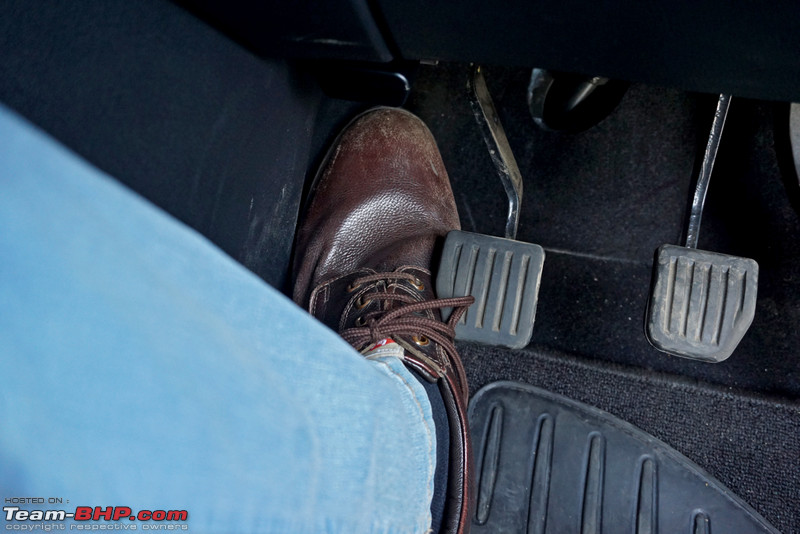 ORVMs are huge and offer good visibility. They are awesome on the highway - offering a great view of what is happening behind, which is especially important when you are at speed. On the other hand, the ORVMs & thick A-pillars cause MASSIVE blind spots while turning, at corners and junctions. Believe it or not, in this picture, there is an entire Maruti Swift hidden behind the ORVM. GTO had a close shave at a junction as well. This is a design failure. Watch out for bikers & pedestrians who are the most vulnerable road users. The driver will have to crane his neck and bend forward on mountain roads. While these stupid ORVMs increase your visibility behind, they totally kill it on the side. Good luck driving the Harrier at night or in the monsoons / foggy conditions when overall visibility is even poorer:  IRVM is wide enough to cover the entire rear windshield, but it is still a size or two smaller than we would have liked. Small windscreen and thick C-pillars restrict visibility. The IRVM didn't feel firmly attached on our test car:  Damn! Automatic dimming for the IRVM is shockingly missing. Standard manual adjuster provided – the kind you get in economy hatchbacks costing 1/3rd the Harrier's price:  While reversing, the rearward view is poor. The rear windshield is small, the C-pillars are thick & the rear quarter-glasses hardly make any difference. Better to rely on the reversing camera and parking sensors:  Center fascia features a touchscreen that sticks out at the top. Piano black has been used all over, along with chrome highlights:  8.8" floating touchscreen head-unit has been covered in a separate post later in the review:  On top, you will see physical buttons for the most frequented audio controls, which we always appreciate. Air-con vents have a shiny black surround panel and chrome tips on the flow directors. There is no knob to control the volume of air and these vents cannot be shut either. The strong cooling power can chill the interiors quickly, even on hot days. Buttons to control the foglamps, hazard lights and Eco / Sport engine modes are located below the vents:  The Harrier has a very powerful air-conditioner. Any changes to the climate control settings are shown on the infotainment screen. The blower has 7 levels of adjustment. It is quiet on level 1, audible on levels 2 & 3, loud on levels 4 & 5 and very loud on levels 6 & 7. Its calibration needs to be tweaked further. Even on level 1, it throws out quite a lot of air. I was driving under the hot blazing sun and never went above levels 1 & 2. Level 2 is like the level 3 or 4 of other cars. If you are the kind who doesn’t like cold air hitting you, you'll have to direct the vents away from you. There's no subtle / soft setting:  USB & AUX ports are inconveniently located too low & deep on the center fascia. They aren't backlit either, making them difficult to access in the dark:  Storage space for your smartphone (at the base of the center fascia) gets a rubber lining on the surface:  The grab handles on the center console are for aesthetic purposes only. They cannot be held as there is a metal mesh blocking the openings below them. They look pretty cool, so purpose served, I guess:  Bird's eye view of the center console. Piano black is used in front of the gear lever as well as on the aero-throttle style handbrake. The gear console has a classy silver border around it. Silver inserts run along the sides of the center console as well:  Rotary knob to switch between the city, wet and rough road modes is placed ahead of the gear lever. These are explained later in the driving post. Buttons for the traction control off & hill descent control are located here as well:  Handbrake looks great from a design point of view, but Tata needs to work on the execution & plastic quality. Engaging the handbrake is simple = just pull it up. To disengage, you need to lift the release button (under the handle) and push the handbrake down. This operation is not intuitive. Worse still, the handbrake squeaks & creaks as you use it. It sounds as if the plastic is cracking. Feels clunky & cheap to operate. Fantastic design, awful execution:  Area below the handbrake gets a rubber top: 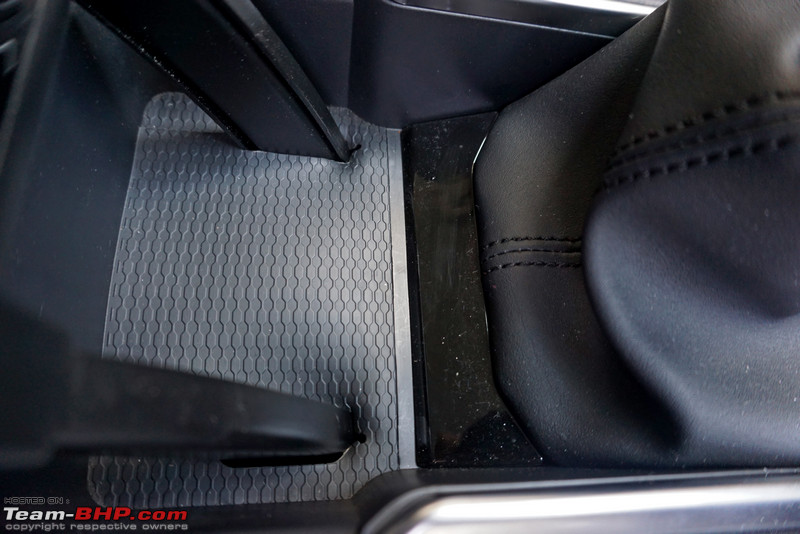 Two cup-holders are located to the left of the handbrake. Each gets two really-nice rubber grips to hold the cup in place. In the center is a can / bottle holder:  Storage bin under the center armrest is deep and gets a cooling vent. It also houses a 12V charging socket. The floor is not rubberised, yet has the same detailing as the storage space at the base of the center fascia, the cup-holders and the area below the handbrake: 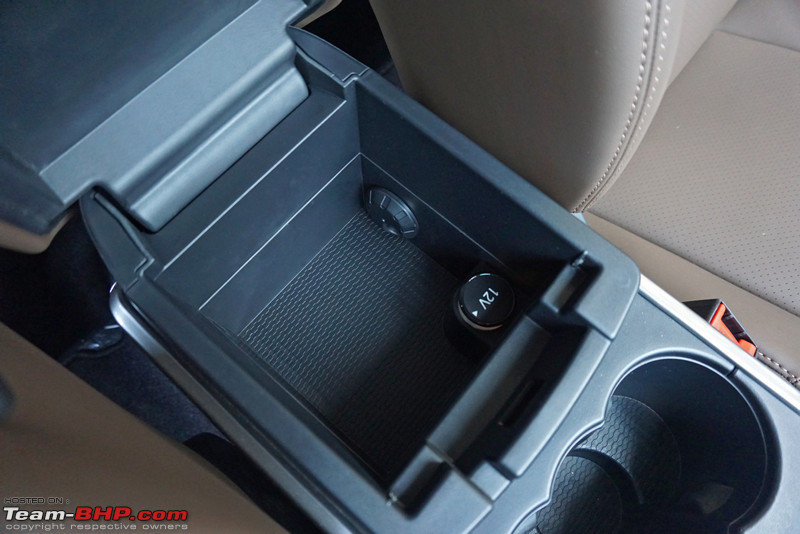 Storage bin (under the center armrest) gets a cutout, so when you plug in your phone charger in the 12V socket and close the armrest, the wire can easily come out: 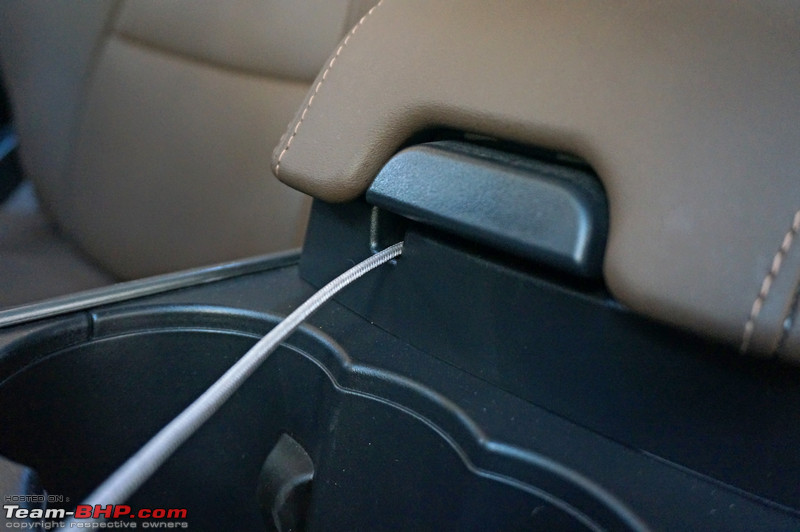 Faux wood paneling and a thick silver line keep things interesting on the passenger's side of the dashboard. See how the air-vent is angled toward the passenger. Sweet! 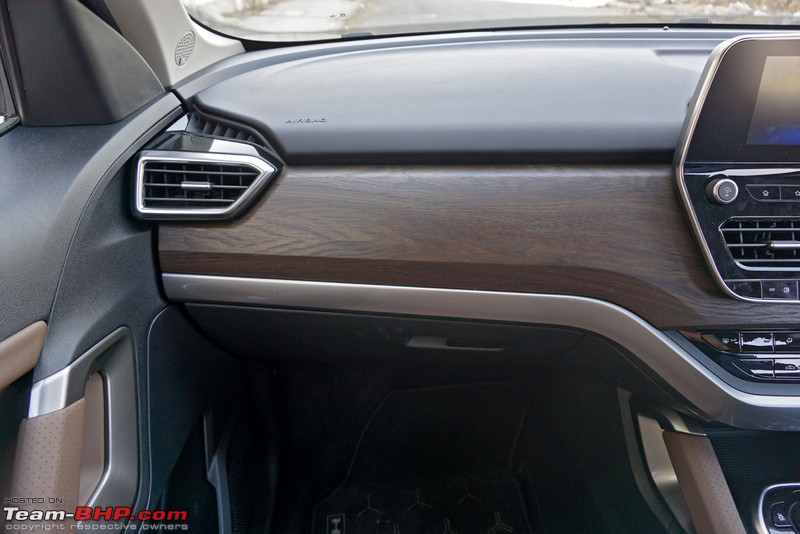 Glovebox is accommodating. It's lid gets a damped action: 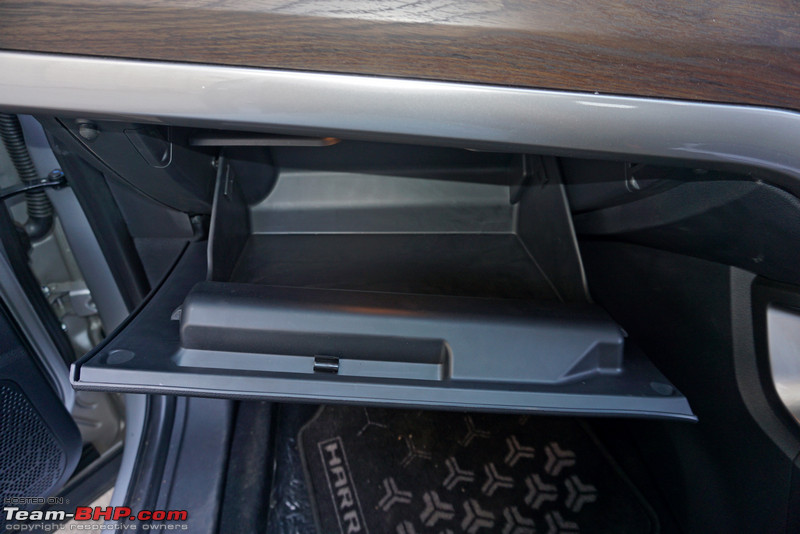 Has two levels. Upper one is best for manual + papers. Gets illumination, but no cooling vent:  A pen holder has been provided... 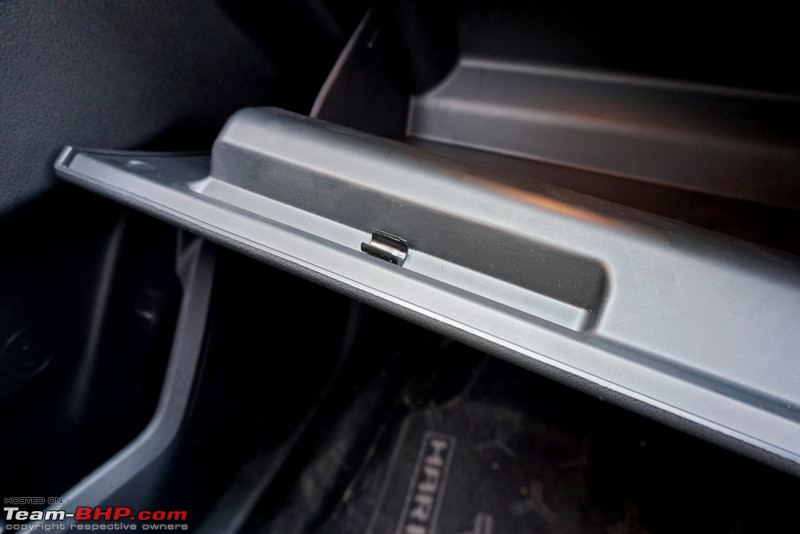 ...and so has a card holder. Zoom in to see how crudely cut the slots are: 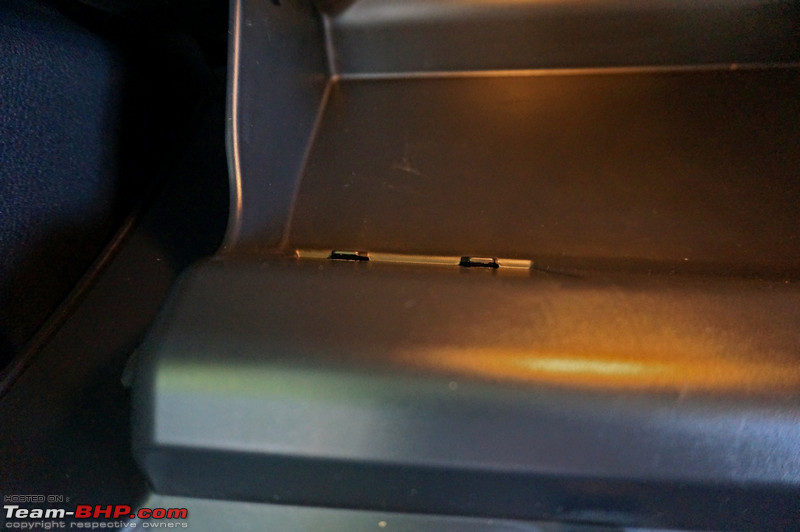 Yikes! Sure didn't expect this in a 20-lakh car. Forget a mirror, the driver's sunvisor doesn't even get a strap to hold toll tickets. Looks so plain-jane & economy grade:  Passenger's sunvisor gets an illuminated vanity mirror with a cover: 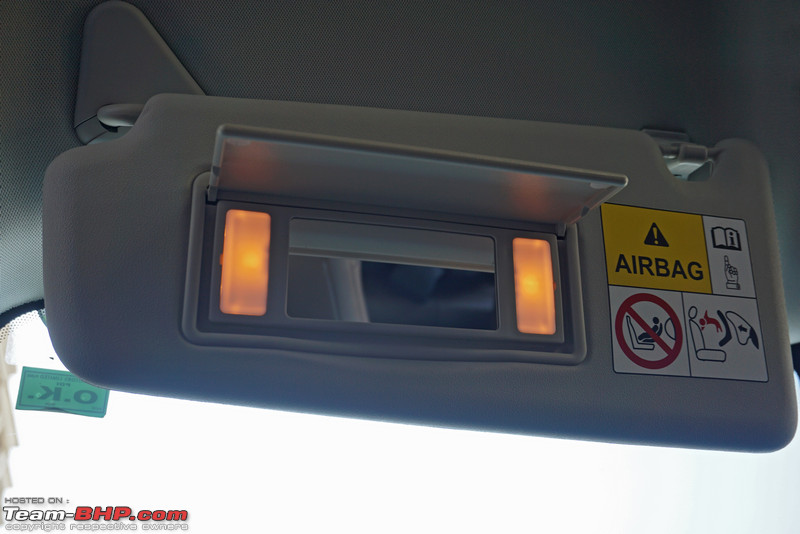 Roof bezel consists of map lights, a central lamp and a sunglass holder. After locking the car, the central light goes out with a theatre-dimming effect. Bluetooth mic is located on the right. Sunroof is sorely missed at this price point (Creta & XUV500 offer one):  Sunglass holder has a soft opening action and a protective lining on the inside to prevent your sunglasses from getting scratched: 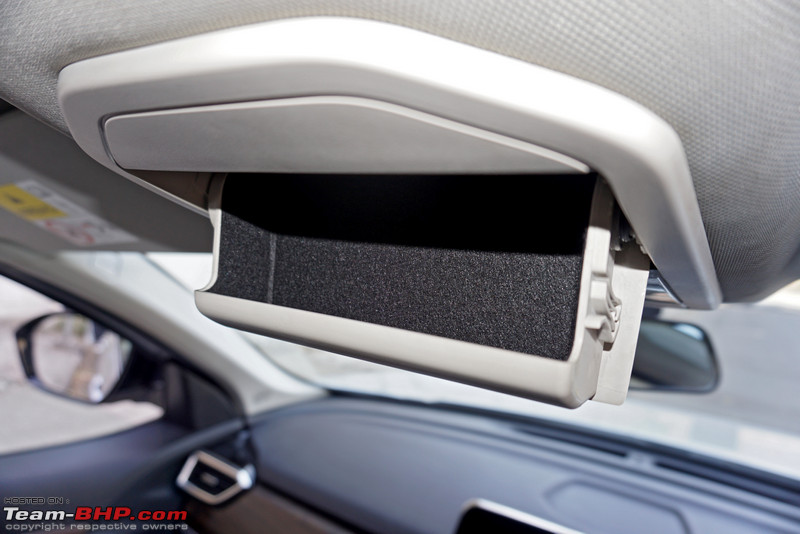 Dual airbags are standard on all variants of the Harrier. XZ trim gets 6 airbags in total. These include dual front airbags... 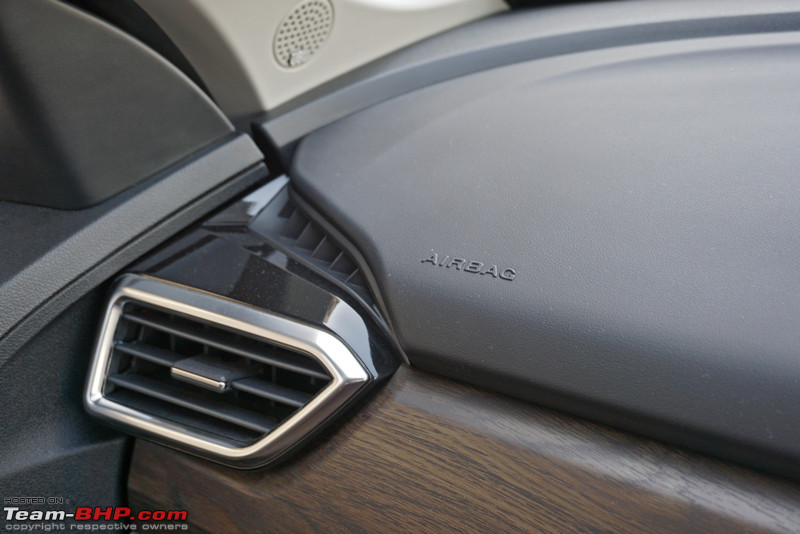 …side airbags (no seat covers please)… 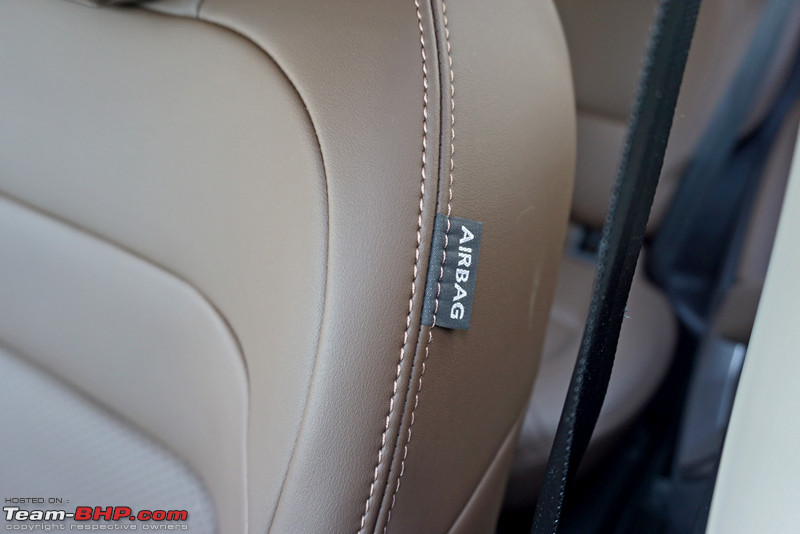 …and curtain airbags: 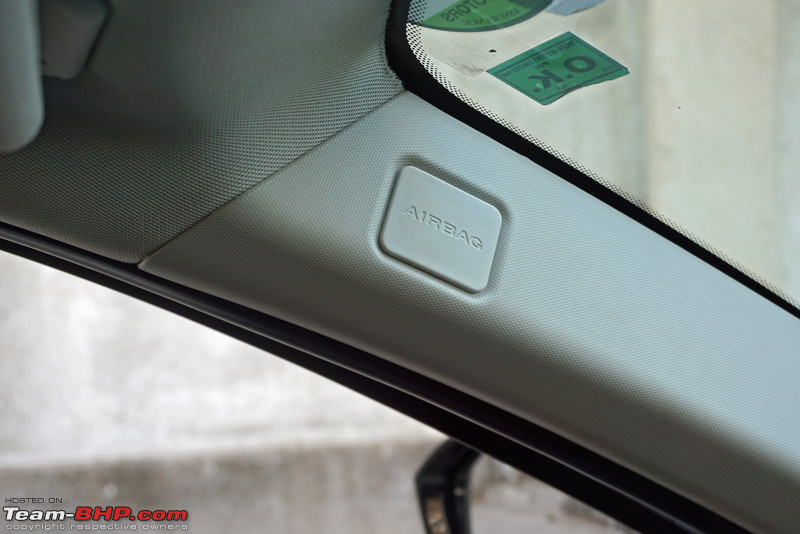 B-Pillar: 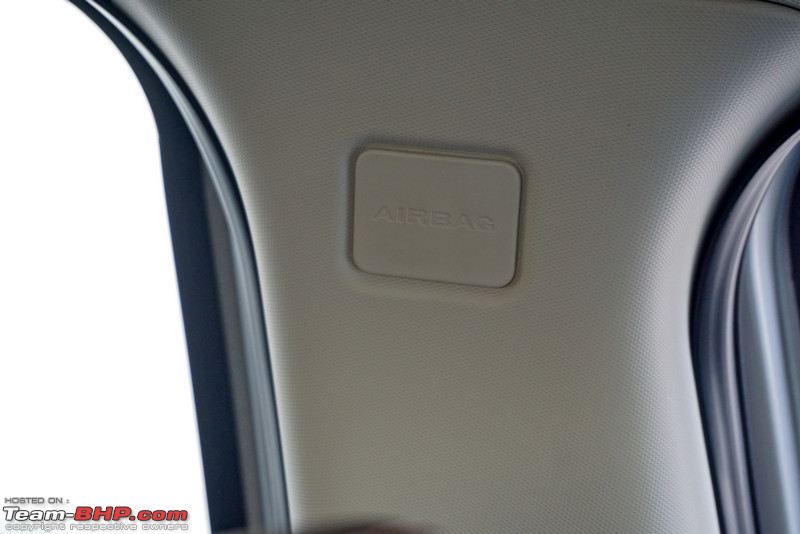 While there are no loose wires dangling anywhere, Tata could have done a better job in the finishing department. There are exposed metal bits & sharp edges as well: 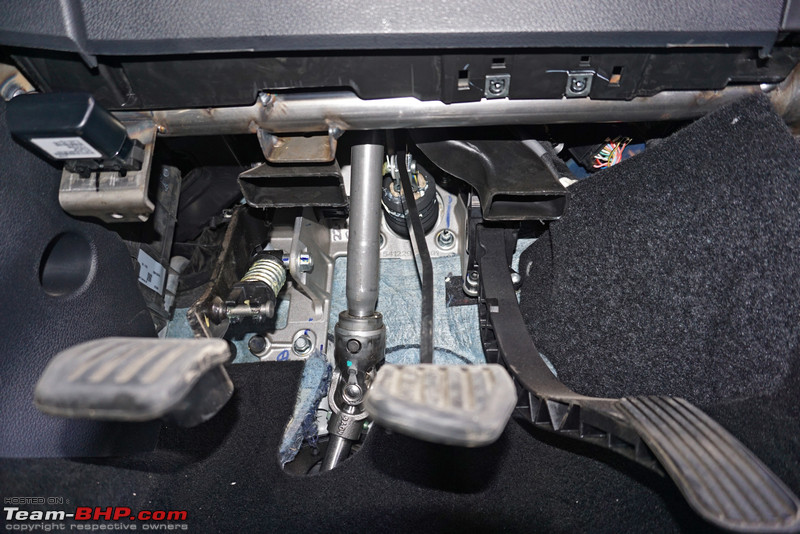 Things are neater & tidier in the passenger's footwell:  A look at the top of the dashboard (center area). Just a design touch. You'll definitely see owners placing a deity / God idol here: 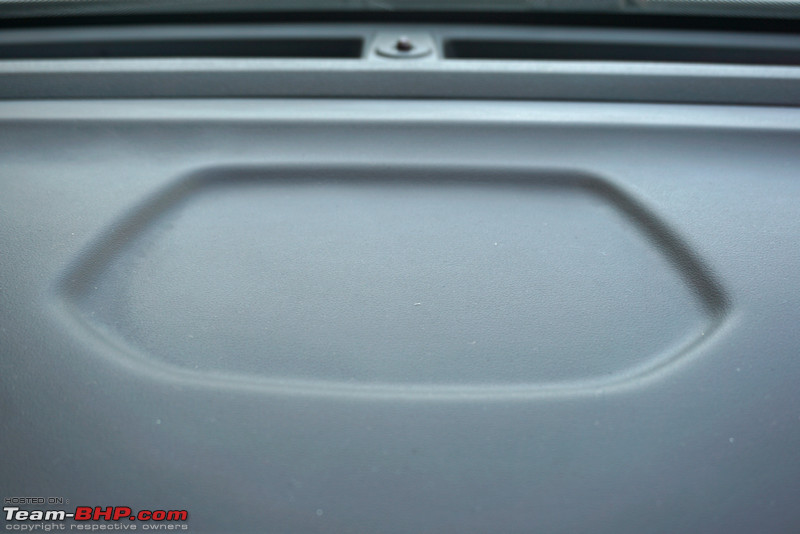 Spring-loaded grab handle above the passenger's door: 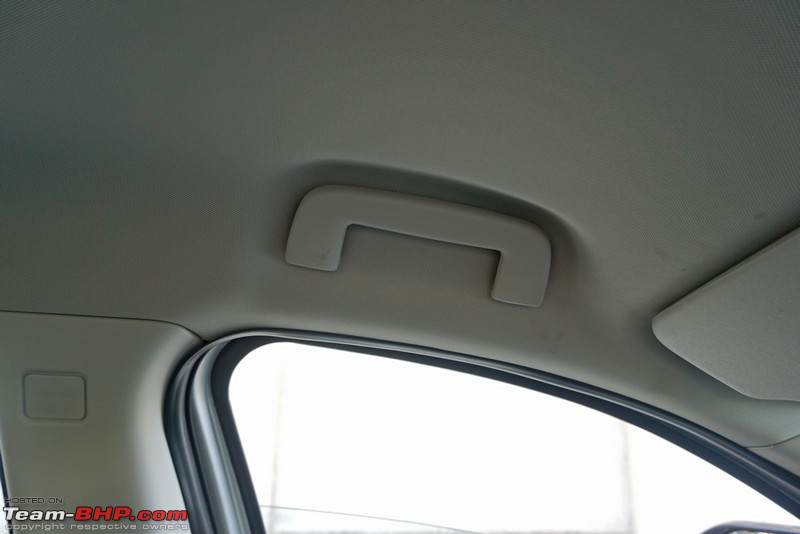 Last edited by Aditya : 1st August 2019 at 12:20. |
| |  (63)
Thanks (63)
Thanks
|
| The following 63 BHPians Thank Aditya for this useful post: | 2himanshu, AkMar, akshay81, arbaz906, AutoIndian, AYP, ChiragM, Dani7766, dean5545, DeepBlueZen, digitalnirvana, Dr.AD, espraveen, FrodoOfTheShire, ganeshb, Gannu_1, graaja, GTO, hmansari, InControl, jailbird_fynix, JoseVijay, joshtronic, keroo1099, lemedico, Leoshashi, libranof1987, Mevtec, MSAneesh, N33raj, NPV, Obi-Wan, Osteon206, PapaKiloSierra9, phoenixash, PraNeel, PrasunBannerjee, Puffdamgcdragon, R2D2, raghu13uk, RaghuVis, RavenAvi, regenitin, Researcher, rohansachar, Scorpion 10, shipnil, Simat, Suchu90, sunny29584, supertinu, swiftnfurious, theexperthand, The_Outsider!, TROOPER, TusharK, uday.ere, vaasu, Varun_HexaGuy, vb-saan, vibbs, Vikram Arya, X_T_A Rose |
| | #5 |
| Team-BHP Support  | Interior - Rear The rear doors of the Harrier open and close in a triple-stage action. They swing out sufficiently wide, and the high roof means that one does not have to bend down while getting in. The seat is also placed at a comfortable height which makes ingress & egress convenient for the elderly. In this pic, notice how long the doors are at the bottom - they cover up the car's (side) running board:  Gap between the B-pillar and seat is more than enough to comfortably move your feet in / out:  Check out the jacking point marked by the black insert on the body. It's present on all 4 doors:  Smart black + brown doorpads. There is a stylish silver grab handle with perforated leather, and a soft leather insert on the rear door armrest as well. A tweeter & speaker on each door (more on that in the ICE post) along with a warning lamp at the bottom:  Doorpads get a flat compartment that can carry a large smartphone with ease:  The door pockets, while not as big as the front ones, are wide and can carry a 1L bottle with some other knick-knacks:  The rear seat is wide enough to accommodate 3 adults. Just 2 headrests though. Both - the seatbase and seatback - have some contours to hold you in place: 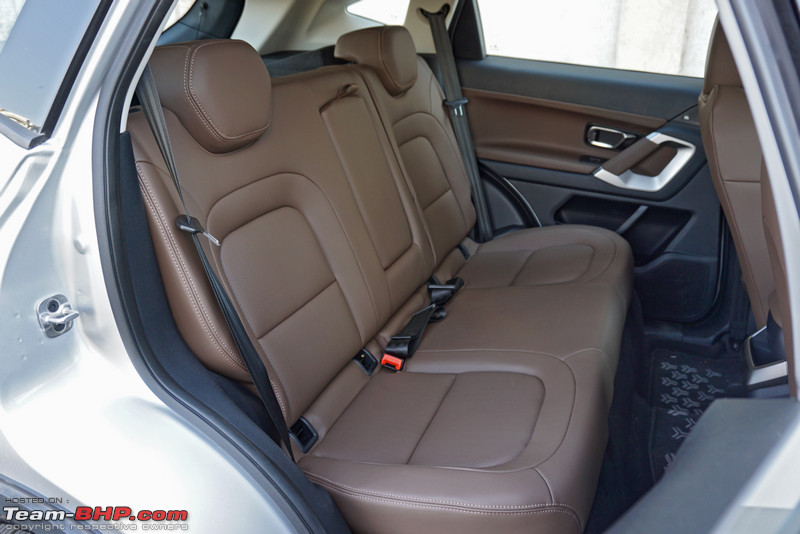 Legroom is generous and two 6-footers can sit one behind the other in reasonable comfort. Tata never disappoints when it comes to rear seat space:  Seatbacks of the front seats are scooped out, which helps in freeing up some more knee room. Both seats get nifty storage pockets:  Cabin width is healthy, which means three adults can sit quite comfortably. Center passenger sits a little higher up due to the slightly elevated seatbase; he also sits a little more in the front because of the center armrest. While the left and right side passengers get 3-point seatbelts, the middle passenger gets a lap belt only:  Seatbelt buckles are parked in dedicated cut-outs:  ISOFIX child seat anchors are available in the XZ variant only, which is a bit disappointing considering new launches are offering them even on the base trim (e.g. Maruti Ertiga, Honda Amaze). They have been provided on both sides:  A look at the maximum and minimum legroom available:  With the front seat in my 5'10" driving position, I have about 5" of knee room to spare. With the front seat moved all the way back, I still have 2" of knee room! The seatbacks of the front seats are soft and scooped out where the knees are placed:  The seatback isn't recline-adjustable, yet the angle is comfortable. Even at my height (5'10"), there is enough under-thigh support. The headrests are soft, adjustable & practical:  The surface at the base of the front seats is soft, so it won't hurt the shin area of your legs. There is enough room under this to tuck your feet in:  Headroom is liberal too. For me @ 5'10", I had a good 3" of clearance. Must compliment the headrests again - their angle is perfect, they are soft and they don't stick out:  Seat has a recessed area in which the headrests can slide down & into. This means they don't jut out and cause discomfort to rear passengers:  The center armrest is positioned at a comfortable height:  It is wide & soft, and comes with two cupholders. Notice the grips to hold the cups tightly in place:  Overall glass area is adequate, although shorter passengers will feel some restriction due to the way the window line slopes upward. Still, there is enough light coming in and the cabin doesn't feel claustrophobic at all. You know what else helps? While the lower half of the cabin is in dark colours, the upper half has a light shade. At this price point, we would have liked to see roll-up sunshades on the rear windows:  Rear window does not roll in entirely:  Two seatback pockets provided. They are adequately deep and wide. These are the best to dump in miscellaneous items. We always put our house keys in here as it's the only place they won't rattle. Plus, if someone breaks into your car while you're dining, this really isn't the first spot a thief will check:  Air-con vents aren't at their usual place. Rear passengers get a smartphone holder…  ...and a USB fast-charging port. It is located low down on the center console, making it a rather inconvenient place to plug your cable in:  Rear air-con vents are placed on the B-pillars. You can adjust the flow direction, but not the volume:  Spring-loaded grab handles with handy coat / bag hooks:  Clean roofliner. While the bottom half of the cabin is dark, it sure helps that the upper half is light:  Rear cabin lamp has two map lights and a main lamp. All interior lights go out with a theatre-dimming effect:  Floor hump is about 3 inches high, and it is wide too. Not good for the center passenger who will have to place his feet on either side of it:  Markings for the curtain airbags on the C-pillars:  Quarter glass behind the rear window is tiny & pointless! Very little light comes in through it. Should definitely have been larger. Another clear example of form over function:  Don’t go just by the on-paper specs. The boot’s rating @ 425 liters might be smaller than cheaper competitors (e.g. Duster), yet we found it to be practical and with a good layout. Thanks to the split tail-lamps, the opening is wide. The loading lip isn't too high either:  As you can see, weekend family trip luggage is an easy fit:  Big parcel tray comes with a recessed area + prominent border. See the projections right behind where the side passengers' heads would be? We asked Tata what that is. The reply = it's a styling element:  Parcel tray has strings which attach it to the tailgate. We sure hope Tata doesn't delete this later, like they did in the Tiago (related thread):  Bigger boot with the parcel tray removed. Weirdly, the Harrier display cars had luggage tie-down hooks, but our test cars didn't (check out this image shared by BHPian Surjaonwheelz). We've never seen these kinds of inconsistencies with a new car:  Boot light is located on the right side...  ...along with a foldable bag hook (load capacity of 2 kg):  Well-finished button to fold the seat down. Looks upmarket:  Rear seat has a split. But instead of the usual 60:40 split, it's a 40:60 (related thread)! The seatbase is fixed and cannot be tumbled forward, like in some SUVs:  Folding the seatback down gives you cargo capacity of 810 liters:  Top tether for the child seat (there's one on each side of the rear seat):  It can be accessed by removing the boot floor:  Tailgate gets full cladding on the inside. No ugly bits sticking out anywhere. Check out the subwoofer on the right:  Boot floor is divided into two segments - a smaller and a larger one. To access the smaller one, use this strap:  Tools are very neatly arranged in a Styrofoam casing:  To access the larger area, a chunky plastic handle has been provided:  Hidden storage space underneath. Can be useful to hide your laptop / electronics, or even valuables (cash, jewellery) being transported:  As mentioned earlier, the spare wheel is carried under the body of the Harrier. To access the mechanism that lowers it, one has to open this plastic flap with the help of a screwdriver provided in the tool kit:  To access the bulbs of the tail-lamps housed on the tailgate, remove these plastic covers:  An old school grab handle to pull down the tailgate. It's not as convenient to use as the modern units that are located on the lower edge of the tailgate:  Last edited by GTO : 14th May 2019 at 10:53. |
| |  (48)
Thanks (48)
Thanks
|
| The following 48 BHPians Thank Aditya for this useful post: | akshay81, arbaz906, AutoIndian, avinash_m, ChiragM, Dani7766, DeepBlueZen, digitalnirvana, FrodoOfTheShire, GTO, hmansari, InControl, JoseVijay, keroo1099, lemedico, libranof1987, MSAneesh, N33raj, NPV, Obi-Wan, Osteon206, PapaKiloSierra9, phoenixash, Puffdamgcdragon, R2D2, RaghuVis, RavenAvi, regenitin, Researcher, rohansachar, samaspire, Scorpion 10, Simat, surjaonwheelz, swiftnfurious, theexperthand, The_Outsider!, TorqueTwist, TROOPER, TusharK, uday.ere, vaasu, Varun_HexaGuy, vb-saan, vibbs, Vik0728, VTec_KickedInYo, X_T_A Rose |
| | #6 |
| Team-BHP Support  | In-Car Entertainment The Harrier gets a Visteon-developed ConnectNext infotainment system with an 8.8-inch floating touchscreen head-unit. It features a high-resolution display, voice recognition, the usual music inputs (USB, AUX, Bluetooth), image & video playback (via USB), on-screen SMS display & readout, voice alerts and a reversing camera display. While there is no onboard navigation, Android Auto & Apple CarPlay integration are offered (just the way we prefer it). Lag is virtually non-existent. Spend some time tuning the equalizer to your preferences and you'll experience top-class sound quality (for an OEM system). The bass punch is enough to make the IRVM vibrate, while the treble can get sharp (if you like it that way). Owners will love the audio quality. With such competent factory ICE, the after-market audio scene will vanish:  The ICE in both our cars had bugs. On my test drive of the silver Harrier, it stopped functioning and a blue screen came up. It refused to go even after the engine was switched off and the car was locked. After 45 minutes, it started working on its own. When GTO took the orange Harrier out, all the left side speakers stopped working within 15 minutes of driving. Shortly after, the front-right speaker stopped too, with just the rear-right speaker working! After parking the car for 2 - 3 hours, all speakers started working again:  Audio output is played through a 320W RMS JBL system with 9 speakers, including a speaker on each of the front doors...  ...the rear doors...  ...a tweeter on the A-pillars with JBL branding...  ...a tweeter on the rear doors...  ...and a 6" subwoofer in the boot!  If you prefer physical buttons, the system can also be controlled using the buttons below the head-unit. A useful "home" button has been provided, along with an equally handy "star" button which can be assigned to your favourite function. Don't miss the shortcut button to access the telephone:  The font size is fair and visibility is good, even under direct sunlight. While the time is displayed on the top of the screen, climate control details are on the top right. The touchscreen can further be used to control the air-con:  Current track is displayed on top of the MID. This arrangement can be turned off (we love it):  Browsing through your music collection is an easy affair:  In addition to the usual equaliser settings, you can choose from a long list of equaliser presets too:  A host of settings can be altered:  These include on / off settings for the voice alert system (e.g. seatbelt warning)...  …park assist volume & tone, and whether it should mix with the music…  ...and the park assist delay timer:  You can disable the DRLs from this screen (please don't, they look good and enhance safety)...  ...and adjust the timeout for the approach lights:  You can also adjust the individual volume levels of each function (phone, startup volume and notifications):  There are two drag-out tabs on the display. The one on the left lets you control the audio & display settings. From this screen, you can turn the display off (if it is distracting you) or decide whether the song being played is cast on the MID or not (cast icon on the lower-right). Cool touch = if you switch off the display, a message first comes on saying "display is turning off" (it doesn't just go out abruptly):  Drag out the right side tab for the climate control settings:  Whenever the climate control settings are altered from the physical buttons, it is reflected on the touchscreen:   Many functions can be controlled through voice commands, including the radio, climate control, phone and media selection:  A guide to voice commands is also provided. We found the system to work well. Unlike in the Yaris, we had no problems at all:  Want to add that the phone call clarity is fantastic:  You can get SMS notifications...  ...choose to have them read out...  ...or reply automatically:  DriveNext function gives you a rating on how well you are using the car. It will give you a star rating based on efficiency, driving characteristics and safety:  Efficiency depends on average speed maintained, fuel economy and engine idling time:  How well you are driving depends on the speed and your use of the accelerator + gears:  Safety rating is based on the seatbelt utilisation, overspeeding, harsh acceleration and hard braking:  The Harrier gets Android Auto & Apple CarPlay. To use them, connect your smartphone to the system via a USB cable:  You can get directions, make calls, send / receive messages and listen to music through this Android interface:  Navigation via Google Maps is obviously superb. Google also gives you real-time traffic updates:  Touchscreen doubles up as a reversing camera display. Together with the parking sensors, it proves to be useful while reversing the Harrier, considering the car's size and poor rearward visibility. On the flip side, the camera quality is poor. It looks like a cheap 100-rupee unbranded import from China (display is otherwise good, hence I'm blaming the camera). Your neighbourhood accessory shop sells better cameras. Tata needs to fix this ASAP:  Yes, those are very-friendly adaptive guidelines which move with steering input. Besides, you get to choose between normal view...  ...and a wider one (just a slight difference between the two). Another issue you might face is that the camera doesn't "instantly start" if you get into the Harrier and engage reverse immediately. The ICE needs to boot up first, so it takes a couple of seconds:  You can zoom in when maneuvering into tight spots (this is the black road!). The touchscreen will indicate if the handbrake is engaged:  At night, the display quality is even worse. There are cheaper cars available in our market with a superior camera display. Seriously, what was Tata thinking?  The ICE can be synced with Tata's ConnectNext app. The app displays the meter readings & DTE. Some chauffeur-driven owners might use this:  The DriveNext App shows you the trip summary & history, fuel efficiency, average speed & more:  ConnectNext includes a remote control for the audio system and climate control:  Last edited by GTO : 14th May 2019 at 10:53. |
| |  (37)
Thanks (37)
Thanks
|
| The following 37 BHPians Thank Aditya for this useful post: | akshay81, arbaz906, AutoIndian, AYP, ChiragM, dailydriver, Dani7766, digitalnirvana, FrodoOfTheShire, Gannu_1, GTO, hmansari, InControl, JoseVijay, keroo1099, lemedico, N33raj, NPV, Obi-Wan, PapaKiloSierra9, phoenixash, R2D2, RavenAvi, regenitin, Researcher, rohansachar, samaspire, Simat, theexperthand, The_Outsider!, TROOPER, uday.ere, Varun_HexaGuy, vb-saan, vibbs, Vik0728, X_T_A Rose |
| | #7 |
| Team-BHP Support  | Driving the 2.0L Diesel MT 2.0L Kryotec diesel is shared with the Jeep Compass. Puts out 138 BHP & 350 Nm:  The Harrier gets a 1,956 cc, 4-cylinder Kryotec diesel engine with an electronically-controlled variable geometry turbocharger sourced from Fiat. This is the same motor that powers the Jeep Compass. Here, it produces 138 BHP @ 3,750 rpm (33 horses lesser than the Jeep) and 350 Nm @ 1,750 - 2,500 rpm (same as the Jeep). The engine is built at Fiat-Tata’s Ranjangaon (MH) facility. The Harrier’s power and torque figures are respectable, although at 1,675 kilos, the car is heavier than other 5-seater SUVs. With a power-to-weight ratio of 82 BHP / ton and a torque-to-weight ratio of 209 Nm / ton, the Harrier can't match the 111 BHP / ton & 228 Nm / ton figures of the Compass. The power ratio doesn't match the Creta's either, however, the Harrier beats the Hyundai in the torque-to-weight ratio. The Tata matches the XUV500 in the power-to-weight ratio and beats it when you consider the torque-to-weight ratio. As you can tell, the best part about this motor is indeed its 350 Nm of torque. The diesel engine comes with selectable driving modes - City (default), Eco and Sport, along with a Land Rover-like terrain response system which lets you choose between Normal, Rough and Wet road conditions. Transmission duties are carried out by a 6-speed manual gearbox, which sends power to the front wheels. An automatic gearbox isn't available at the moment. Considering how well Tata mated an automatic to the Hexa, we are surprised this car does not have an AT. A competent AT mated like that could expand this car's appeal twice, thrice, maybe four times over! It's an accepted fact now that Rs 20-lakh customers love their slushboxes. Though we expect one to be available later, there is no doubt that the Harrier’s acceptability is being restricted by the lack of an AT today. An all-wheel-drive system is not on offer and we don't see it coming anytime soon. Press the long travel clutch, hit the engine start button and there is noticeable body shake as the diesel fires up. At idle, there are vibrations felt on the steering as well as the pedals. The diesel moves off the mark effortlessly. As is typical of big turbo-diesels, the 2.0's low end is superb & overall driveability is good. 2nd gear test over a speed-breaker? Easy as pie. Heck, it can even take off from a standstill in 2nd gear! You won't be using the gear shifter too much in the city and depending on the traffic density, you could use either 2nd or 3rd like an automatic. There is some lag below 1,500 rpm, but it’s not excessive at all; you can start pulling the engine from ~1,200 rpm itself. However, one has to be careful not to let the revvs drop too low as the engine will suddenly stall. Don't lug this engine even in 2nd or 3rd gears. On the open road, the Harrier is quick and you can make fast progress (not Compass or Creta-fast though). The mid-range is simply fantastic and gets very addictive. The engine comes into its stride once the needle crosses 2,000 rpm, with a nice spike of torque. You'll enjoy the punch & it pulls very nicely till ~4,000 rpm. Accelerate hard & the 350 Nm leads to torque steer in 1st gear, 2nd gear...even 3rd! Because of the sensitive steering (more on that later), keep a firm hand on the wheel. The torque on tap means you don't have to shift down much to overtake. On the expressway too, light overtaking is taken care of in 6th gear itself. Push the engine and it will revv to ~5,000 rpm in Sport mode, but honestly, there is no point doing this. Not only does it get noisy beyond 3,000 rpm, but it also runs out of muscle past 4,200 rpm or so. The engine has no top end to speak of. When you want to cruise, the diesel can be an able mile muncher. It ambles along at 100 km/h & 120 km/h in 6th gear at just ~1,800 rpm and ~2,200 rpm respectively. That's a very relaxed cruising ability. Another small touch which we appreciate = the 120 km/h speed warning isn't that irritating (e.g. Honda CR-V's was much louder). The Harrier gets two selectable driving modes (apart from the default City mode), which switches the engine map. Whenever you change the mode, a female voice tells you what mode you've just activated. Eco Mode – Switching to 'Eco' mode makes the throttle response duller. This mode limits the power output and the engine uses less fuel as compared to the other modes. Even the revvs are limited to 4,500 rpm. Despite that, the low-end torque makes Eco mode usable in the city. In fact, it worked very well in bumper-to-bumper traffic. On the highway, this mode can be used for cruising. Only when you want to overtake slower moving traffic in a hurry will you want to switch to one of the other modes. Sport Mode – As expected, switching to Sport mode makes the car more responsive to throttle inputs (in terms of pedal and engine mapping, both). A slight dab on the accelerator and the difference is immediately felt. If you use it in the city, it'll take some time getting used to as the power delivery can get spiky. That said, once you get the hang of it, we'd suggest using this in the city as the driveability is the BEST in Sport mode...the engine pulls easily. The motor also revvs to 5,000 rpm in this mode. Goes without saying that Sport is our mode of choice on the highway. The improved power & throttle response are always welcome, whether you want to cruise fast or overtake. The clutch of our brand new test cars was neither light nor heavy – it was middle of the way in terms of weight, and longer in travel than the usual monocoque crossovers. Surprisingly, the gear shifter is notchy, especially for the 1st & 2nd gears which you’ll use most frequently. Its gates are well-defined though. Tata has been careless here and should have made it lighter and smoother (no rocket science in accomplishing that). While the throws are not long as say the Hexa’s, they are certainly not as short as the Creta’s. The Harrier is a hit & miss in the NVH department. A few parts are good, while others are terrible. There is noticeable body shake on startup and shutdown - not something you expect in monocoque SUVs (try the Creta). At idle & regular commuting revvs, engine sound is fairly controlled. Each time you accelerate though, the diesel's noise is heard inside the cabin. The engine starts getting loud above 3,000 rpm. Over 4,000 rpm, it starts screaming and what's worse, the engine note is sad (even by diesel standards). Your annoyed passengers will tell you to take it easy & shift up early. On the other hand, wind noise is kept out of the cabin impressively well, even at triple digit speeds. In fact, wind noise is almost zero at legal speeds - I wasn't even raising my voice when speaking to passengers at 110 km/h! The suspension too goes about its work silently, while road noise remains well-controlled. Drivetrain vibrations are felt on the clutch & these are directly proportional to the rpm level. We felt some vibrations on the steering as well. While the gear lever doesn't dance around, you will observe some back and forth movement (of the gear lever) when you press & release the accelerator. All of this isn't cool in a car that can cost 20 lakhs on the road & there is simply no comparison to the super-refined Creta. Coming to fuel economy, the Harrier diesel has an ARAI rating of 16.7 km/l. That's higher than the XUV500's 16 km/l, but behind the smaller Compass (17.1 km/l) & Creta (19.67 km/l). Transverse-mounted diesel is an easy fit inside the Harrier's engine bay. Lots of empty spaces around. We prefer it this way, as compared to say, the Marazzo's crazily-cramped bay:  The bonnet is h-e-a-v-y & opens high! It's held up by a manually-operated rod. Lightly built or shorter owners will wish that it had pneumatic struts for assistance (the Hexa has them). Insulation sheet provided under the bonnet:  Kryotec-branded engine cover:  Variable-geometry Honeywell turbo sits just ahead of the engine:  On top of the air duct assembly is this unique S-shaped piece. Tata says "it is a sound-absorbing material for enhanced NVH performance":  Remove this cover above the firewall on the left-hand side...  ...to access the brake fluid reservoir:  Battery is placed on the right and can be accessed...  ...by removing a plastic cover:  6-speed gear shifter gets a leather boot and leather-wrapped knob, with a glossy black top. However, the lack of attention-to-detail is inexcusable in a 20-lakh car. See how the numbering is all crooked. Check out this image (shared by BHPian Spindoc) to view just how misaligned the printing is:  Reverse gear is engaged by lifting this button:  The selected drive mode is projected in the instrument cluster. While "City" is shown in white, "Eco" is in green & "Sport" in red. God is in the details, we say!  The selected drive mode is flashed on top of the touchscreen head-unit too (along with a female voice prompt):  Gearshift suggesting tool has been provided. Newbies will appreciate this feature. However, it only shows the up or down arrow sign, next to the current gear engaged (some cars now show you the suggested gear number too):  Last edited by Aditya : 15th May 2019 at 10:18. |
| |  (44)
Thanks (44)
Thanks
|
| The following 44 BHPians Thank Aditya for this useful post: | 2himanshu, AkMar, akshay81, AutoIndian, AYP, ChiragM, dailydriver, Dani7766, danielsinghin, digitalnirvana, espraveen, GTO, hmansari, InControl, jithin23, JoseVijay, keroo1099, Keynote, lemedico, libranof1987, MSAneesh, N33raj, Nalin1, PapaKiloSierra9, phoenixash, R2D2, RavenAvi, regenitin, Researcher, rohansachar, samaspire, Simat, spindoc, swiftnfurious, theexperthand, The_Outsider!, TorqueTwist, TROOPER, uday.ere, vaasu, Varun_HexaGuy, vb-saan, vibbs, X_T_A Rose |
| | #8 |
| Team-BHP Support  | Ride & Handling The Harrier is equipped with an independent McPherson strut front suspension with coil springs and an anti-roll bar, while the rear is a semi-independent twist blade design with a panhard rod. While the front is very similar to the Land Rover Discovery Sport, the rear suspension has been tuned by Lotus Engineering, UK. The Harrier's ride quality is mature, but has a firm edge to it. At city speeds, it is compliant enough and the Harrier's occupants will be kept comfortable. No owner will complain. Still, it's not what we would call "plush" & there is simply no comparison with cars like the Duster & Hexa. The sharpness of potholes is obvious inside & you'll feel the suspension's firmness on bad roads (with some side-to-side movement of the cabin too). This isn’t a car that can flatten bad roads like the Duster / Hexa. Just to add, we found the front suspension to be softer / more compliant than the rear. On the highway too, the Harrier's ride quality is compliant & adequate. Yet again, it's not going to round off bumps like the Hexa can and you will always be aware of the kind of road you are driving on. Our test vehicle was running on 17" wheels, while lesser variants get 16" rims with taller rubber. The ride quality on those will be cushier. What's nice is that the suspension goes about its job silently - it's not clunky or loud. Straight line stability is good, even at high speeds. Additionally, the Harrier isn't bouncy at speed and the rear end recovers quite quickly from expressway up / down undulations (the Creta keeps bouncing about from these road dips). Grip levels are satisfactory from the chassis & 235 mm tyres, but this isn’t an SUV that we’d call a corner carver. Body roll is present and you feel the Harrier’s height + weight. Still, all of this is fine and the behaviour is acceptable. What really kills it is the horribly tuned steering at speed. It's so terrible that we're going to use an entire paragraph talking about it. The Harrier's hydraulic steering is poorly calibrated - we'll give it a 4 / 10 rating. Within the city, the steering is alright. At parking speeds, it is a little heavier than expected & requires effort. As you start driving though, we found the steering's weight to be perfect in the city (it's just right, not super light). Get out on the highway though and you'll find the stupid steering to be way too light & sensitive...so sensitive that it's outright dangerous at 110 - 120 km/h! The steering is simply too quick - at 110 km/h, even a small input from the driver results in a larger-than-expected direction change. This light + sensitive steering makes the Harrier's front end dangerously twitchy. Vid6639 drove the orange Harrier on the expressway and said that we'll be seeing a lot of crashed Harriers on Indian highways. A layman won't be able to handle an emergency manouveur; Tata needs to fix this ASAP. All we can state for now is, maintain a firm hand on the steering and be gentle + slow with your inputs. The lousy steering actually made us back off on the Lonavla ghats that we're so familiar with. In terms of overall highway behaviour, the steering is the single negative point of the Harrier...and a major one at that. In addition to the switchable engine remaps mentioned in the engine post, the Harrier gets a Land Rover-esque terrain response system with two selectable modes (apart from the normal driving mode). Wet Mode is designed for driving in the rain by providing better traction and handling. If you should hit a rough patch on your holiday outings, Tata has you covered there too, with the Rough Road Mode which optimizes the vehicle's behavior on broken roads. Braking performance is also tuned to support rough road surfaces. This is all software trickery that can work well. We didn't get an opportunity to test either of these and their verdict will depend on the most reliable reports of them all = Team-BHP Ownership Reviews. The 205 mm of ground clearance is impressive (though curiously, the smaller Nexon has 4 mm more). We did not scrape the car anywhere. Even when we took it a bit offroad for photography, the Harrier breezed through the terrain. Can't help thinking how, with this tractable engine, high ground clearance, short overhangs, hill descent control and terrain response modes, the Harrier is a fitting candidate for an AWD system. Hope Tata plans to bring one. The Harrier's turning radius of 5.8 meters is big. It's wider than all direct competitors...in fact, the turning radius is on par with the huge Toyota Fortuner's. Expect more 3-point turns than necessary in the city. Within urban confines, the Harrier isn't as easy to drive as the Creta or Compass due to its size, steering weight, long clutch, blind spots & ergonomics (for many drivers). ABS & EBD are standard on all variants of the Harrier, while the top XZ variant further gets ESP, hill hold + hill descent control, brake disc wiping, brake pre-fill, hydraulic brake fade compensation, rollover mitigation, traction control and cornering stability control. The Harrier has disc brakes at the front and drums at the rear. While we would have liked to see discs at the rear, we can tell you that the braking capability is just fine and no owner will have any complaint. We jammed the brakes at high speed too and the Harrier stopped straight & true, with no drama. The ABS doesn't kick in unless really necessary (we like it this way). Please note that the bite from the brake pedal is sharp and will take some getting used to when you are new to the car. Lastly, the softer front means there is nose dive under braking (and nose rise under acceleration!!). Independent McPherson strut suspension with coil springs and anti-roll bar at the front:  Terrain response modes are projected with brilliant graphics on the MID!  In addition to the usual 80 & 120 km/h audible alerts, a small orange coloured “speed limit” sign comes on (below the temp gauge) when you cross 80 km/h:  Last edited by GTO : 14th May 2019 at 10:51. |
| |  (56)
Thanks (56)
Thanks
|
| The following 56 BHPians Thank Aditya for this useful post: | 2himanshu, akshay81, AutoIndian, AYP, bvasista, ChiragM, dailydriver, Dani7766, dean5545, digitalnirvana, Dr.AD, espraveen, FrodoOfTheShire, Gannu_1, gauravanekar, GTO, haisaikat, hiren.mistry, hmansari, InControl, itsashishsharma, jailbird_fynix, jithin23, JoseVijay, keroo1099, Keynote, MSAneesh, N33raj, nainan, NPV, Osteon206, phoenixash, PrasunBannerjee, Pythonista, R2D2, RavenAvi, regenitin, Reinhard, Researcher, ROG_AK, rohansachar, samaspire, Scorpion 10, shipnil, Simat, SS-Traveller, swiftnfurious, The Rationalist, theexperthand, The_Outsider!, TorqueTwist, TROOPER, uday.ere, Varun_HexaGuy, vb-saan, X_T_A Rose |
| | #9 | |
| Team-BHP Support  | Other Points • Manufactured at the Tata Motors factory @ Pimpri - Chinchwad, Maharashtra. Just FYI, the Nexon & Compass are built at Ranjangaon. The first Harrier rolled off the production line on October 30, 2018. Tata claims that a completely new assembly line was built in a record time of 6 months (frankly, it shows), with manufacturing practices adopted from Jaguar-Land Rover. It boasts of 90% automation levels with over 100+ KUKA and ABB robots. • Going by the many niggles in both our test cars, and owners reporting more of the same (sample link), there is no doubt this is a hurried launch. Honestly, the Hexa & Nexon felt a lot more “sorted” at their launch. Our recommendation = Wait for the 2020 version, if not the 2021. It’ll be much improved & (hopefully) free of issues. For such a big launch, one puts their best foot forward. It is simply inexcusable that Tata goofed things up by providing poorly finished cars at mall displays, to the media, early customers etc. Even if you look at the production numbers (a yo-yo between 1,500 to 2,500 units / month - link), it clearly shows that Tata wasn't prepared & production has yet to be streamlined. • The niggles faced by us include the terrain response system going dead + engine modes not being selectable + ESP & hill-hold disabled, a malfunctioning smartkey (wouldn't open the tailgate), ICE head-unit going dead, speakers randomly going kaput, the MID clock getting stuck @ 11:38, steering-mounted button getting stuck, speedometer needle resting between 4 - 10 km/h (instead of 0 km/h), ORVMs not unfolding when the car was unlocked & engine started, a terribly unsorted steering at speed and some miscellaneous others. An owner faced a radiator leakage & overheating problem on his month-old Harrier. Going by these issues on brand new cars, we feel the long-term reliability of the 2019-build Harriers could be poor. Again, our recommendation to BHPians is to wait for a year or two (more the better) before buying the Harrier. Tata should've sorted out all these issues by then. The car definitely has the potential to be "great', but for that to happen, Tata has to really polish the car & pull the weeds out. If it weren’t for these rough edges & problems, the Harrier would be one of our top recommendations in the segment. GTO says that the car could be absolutely "kick ass" if & when Tata ties all the loose ends together. • Being how important the Harrier is – perhaps the most important launch of 2019 – we spent a LOT of time with it to paint an accurate picture for you. 4 highway runs (usually we have 2 highway runs) with 4 Mods driving it. Our test-drive notes ran 19 pages long, while our total checklist was about 25 pages  !! !!• Trivia: The Tata Group had a 'Harrier' in its portfolio long before this one. Thanks to BHPian rrsteer for sharing details about the Tata Stryder Harrier mountain bike. • If Tata had brought out a fully finished product and with a competent AT, the Harrier could have been a game-changer. It’s missed that opportunity just because the Pune folks didn’t prepare for this important launch as well as they should have. Weird that they seemed to have been better prepared with the Hexa (which was a less crucial product) & Nexon. Here’s a BHPian who drove the Hexa & Harrier, was put off by the latter and bought the Hexa (link). • The engine name KRYOTEC is inspired from Cryogenic rocket engines. • The Harrier has a huge deal of enthusiasm & hype around it. Such is the excitement that a gentleman danced in joy on seeing the car at a showroom. Our original Harrier thread has garnered 42 lakh views! We feel this review thread will eventually cross a crore views (like the EcoSport). • Available in four variants – XE, XM, XT and XZ. • Weird that ISOFIX is available only on the top variant, while a very-crucial rear defogger is offered only on the XT & XZ variants! There are cheaper cars offering ISOFIX even on base variants. Tata should make both of these safety features standard ASAP. • Available in 5 body colours - Calisto Copper, Ariel Silver, Thermisto Gold, Orcus White & Telesto Grey. While the XE variant is available only in Orcus White, the XM is not available in Calisto Copper. Our 1st choice is the Calisto Copper (orange). The Harrier looks absolutely stunning in that well-chosen shade. • Loved the Harrier's dual-tone horn! A tasteful choice. • Surprised to see a torsion-beam rear suspension. Would have expected an independent rear which the XUV500 offers (but the Creta doesn’t). While the front suspension was taken from the Land Rover Discovery Sport, the rear suspension wasn't copied, due to its cost. • We had parked the Harrier overnight and got to it at 1430 hours. It was directly under the blazing sun and therefore, the cabin was baking hot! Started the car and rolled down all the windows. In about 40 seconds or so, it was already blowing out cool air! We think that’s pretty quick (outside temperature was 37 degrees). On the other hand, the climate control did behave funnily at times. Setting the temperature on "20" would make things cold, while "21" would suddenly make it warm. Weird. An owner reported that, in his Harrier, changing the temperature setting anywhere between 18 degrees - 30 degrees made no difference to the cooling. • For driving pleasure, the Jeep Compass is still the best ~20-lakh SUV you can buy today. • Not giving an Automatic in a segment that loves ATs shows that Tata simply hasn’t done its homework. The Hexa’s automatic gearbox is superbly tuned, so Tata definitely has the skill to pull it off. They’re going to lose a lot of customers because of the missing AT. Jeep India has been careless too in not offering the AT on the Compass (same engine). • The Harrier is rumoured to be getting a Hyundai-sourced automatic transmission in the coming months. A spy image of the car surfaced in March 2019. • Team-BHP had broken the news that a few prototypes of the Harrier were exported to USA for testing in July 2016. Tata claims that the Harrier has been tested for a cumulative distance of 2.2 million km over various temperatures, terrains and altitudes. • "Hill hold" will hold the car for 3 seconds on an incline, giving you enough time to move your foot away from the brake pedal and onto the accelerator. • Labour-free services are at 1,500 km / 2 months, 7,500 km / 6 months and 15,000 km / 12 months. Rather short service interval of 7,500 km / 6 months, we say! 12 months & 10,000 or 15,000 km is pretty much the norm today. This effectively means that your Harrier will be visiting the workshop with twice the frequency of most Indian cars. • Tata is also offering AMCs that are categorised under "Silver" and "Gold" contracts. The Silver AMC includes consumables (oils, filters, alignment, balancing etc.), while the more comprehensive Gold further includes brake pads, clutch discs (surprisingly!!), suspension bushes, wiper blades and other wear & tear items. Prices for the 1 year / 15k km contract for the Silver and Gold are Rs 11,055 and Rs 13,765 respectively, while the 4 year / 60k km Silver and Gold contracts amount to Rs 73,277 and Rs 1,05,436 respectively. • In what can be seen as a fake & misleading marketing gimmick, Tata had released fake prices earlier that were intentionally higher than expected (the car eventually launched at a lower price). As expected, a "car rag" published the fake prices too. Full details in this post. • A 7-seater version of the Harrier called the Buzzard was unveiled at the Geneva Motor Show in March 2019. The concept is called the H7X and is likely to be named "Cassini" when it goes on sale. It will have the same engine in the Compass' 171 BHP tune. The Buzzard's 3rd-row seats are best only for kids though. • Doors auto-lock at 20 km/h. All doors "unlock" when the engine is switched off. As much as we're fans of auto-locking, we hate any kind of auto-unlocking. Our country is too crime-prone for that. • Unlock the car, but don't open the door...and the car locks itself back in 30 seconds. • Walk away from the car with the engine running + smartkey in your pocket, and the horn starts sounding prominently (happens even in accessory or ignition modes). This is a must-have warning in any car with passive keyless entry & go. All other manufacturers should adopt it. Vid6639 once dropped off his EcoSport for a service and came back home with the key in his pocket. Worse still, he'd handed it over to a service advisor who took the car for a test-drive without the key! The usually-attentive GTO once handed his 530d over to a friend, and walked away with the smartkey (his friend had already driven away). • Wipers have a courtesy sweep feature (i.e. a single delayed sweep after the windscreen is washed). • The lower variants get a smaller ICE head-unit & MID. Check them out here. • Dual-tone crossovers are quite the rage today. Wondering if you should do it to your Harrier? Click here for a picture & video of a handsome white Harrier with a blackened roof + rims. • BHPian AutoNoob says that Tata might introduce a sunroof, as well as a black body colour option (link). Can’t wait for black? Check out the deadly “satin black” body wrap here. • Tata has added a sweet online configurator, with accessories such as front cornering lights, roof rails, mood lighting & more. Click here for more details. • Full list of accessories with pricing can be viewed in this post. • Launching a car with so many niggles like this is going to do nothing to Tata’s reputation, which was only just recovering in the last 3 years. There are many people who still won't consider a "Tata car" due to the baggage it comes with. Introducing a Harrier laden with problems is a step back for the brand. • The Kia Concept SP sure has a side profile that's dangerously similar to the Harrier's. Thanks to BHPian Durango Dude for sharing comparo pics in this post. • The Tata Harrier brochure can be viewed here - Tata Harrier.pdf. • Has the following 3 noteworthy safety features: Quote:
Last edited by GTO : 15th May 2019 at 07:36. | |
| |  (59)
Thanks (59)
Thanks
|
| The following 59 BHPians Thank Aditya for this useful post: | abhinavinc, AkMar, austere_sly, AutoIndian, avinash_m, ChiragM, dailydriver, Dani7766, danielsinghin, dean5545, digitalnirvana, Dr.AD, espraveen, FrodoOfTheShire, gauravanekar, GTO, hiren.mistry, hmansari, InControl, jailbird_fynix, JoseVijay, lemedico, libranof1987, MaheshY1, mh09ad5578, MSAneesh, myavu, N33raj, nainan, Nalin1, NPV, PapaKiloSierra9, phoenixash, PrasunBannerjee, R2D2, Rajeevraj, RavenAvi, regenitin, Researcher, ripy002, rohansachar, samaspire, Scorpion 10, shipnil, Simat, srikanthmadhava, swiftnfurious, Tanveer02, theexperthand, The_Outsider!, TorqueTwist, TROOPER, uday.ere, vaasu, vb-saan, VeluM, vibbs, Vik0728, X_T_A Rose |
| | #10 |
| Team-BHP Support  | The Smaller yet Significant Things We LOVE the style! Puddle lamps (under the ORVMs) project an outline of the Harrier on the ground:  50L fuel tank is surprisingly smaller than the Harrier's direct rivals like the Creta (55L), Compass (60L) & XUV500 (70L):  Xenon projector headlamps do a good job of lighting up the road ahead:  Regular halogen units are used for the high beam, but their throw is brilliant!  Smartkey is identical to the Nexon's. It is nicely finished and feels premium. Headlights can be activated by pressing a button on the smartkey (to help you find your way in the dark). Shiny black border looks tasteful. On our silver test car, the boot release button did not work:  Full cladding in the front wheel well...  ...and in the rear. Road noise is well-controlled:  In our test car, the speedometer needle would rest anywhere between 0 - 10 km/h when stationary. We've never driven a car with so many inconsistencies:  The Harrier's dietary preference is marked thrice. In a country full of careless petrol-pump attendants (and owners too), this is a must-have. A small plastic hook is provided on the fuel flap...  ...to hold the cap while fueling:  Google Map directions are displayed on the MID (via Android Auto). Super cool!  Driver & front passenger get individual seatbelt reminders ("D" denotes the obvious). The driver reminder comes on even if the car is stationary. There are audible warnings, and a voice prompt as well:  Passenger seatbelt warning comes on only if the passenger hasn't buckled up & the car is moving. Above ~17 km/h, an audible warning starts beeping continuously. The sensor appears to be very sensitive. This came on even if I placed a small camera on the seat:  More niggles. Button to scroll through the MID would get stuck at times:  This amber indicator comes on when the DRLs are running. So basically, it stays on permanently, unless you disable the DRLs:  Door ajar warning (in the instrument cluster) tells you specifically which door is open. It covers the tailgate too, but not the bonnet (about time all manufacturers add bonnet coverage IMHO):  A premium touch = faux leather covers up the ugly gap between the dashboard & steering console:  All interior buttons are backlit in white:  Very little clearance between the door handle & grab handle. You cannot wrap your fingers around the door handle and pull it to open the door. Some BHPians were concerned that your finger could get hurt here too. Well, after spending a cumulative 11 days with the Harrier in Mumbai & Rajasthan, we didn't face any such problem. In theory, the gap is less, yes. But it didn't affect the functionality in anyway:  This is the seat mount (front seats) whose bolts are nicely concealed with plastic covers. We really like this treatment:  Ditto for the rear seat:  Superb pattern on the floor mats. Manufacturers should experiment like this, instead of the usual boring mats we see:  While the driver's mat has a button-like arrangement on the underside...  ...there is no provision on the floor to hold it in place!!! Looks like somebody forgot what he was supposed to do:  Door's rubber beading is soft, of good quality and well-fitted. A felt-like layer of beading has been used as well. Wind noise is kept out exceptionally well:  Tyre pressure of 33 PSI to be maintained at the front & rear, irrespective of the number of people in the car:  Yep, the huge ORVMs are India-friendly and will move the other way if a biker side-swipes them:  17-digit VIN is stamped on the body frame, near the driver's seat:  See this cowl over the instrument cluster? In early Harriers, it actually came off & you could literally see the glue!!! Click here to see the ugly image. Thankfully, later Harriers appear to have this fixed:  Look at the top 3 and you know what the masses are comparing the Harrier to:  Last edited by GTO : 14th May 2019 at 10:49. |
| |  (57)
Thanks (57)
Thanks
|
| The following 57 BHPians Thank Aditya for this useful post: | aabhimanyu04, ads11, AkMar, akshay81, AutoIndian, aveoman19, avisidhu, AYP, ChiragM, danielsinghin, digitalnirvana, Dr.AD, DrANTO, espraveen, FrodoOfTheShire, ganeshb, Gannu_1, Geo_Ipe, GTO, hiren.mistry, hmansari, InControl, jithin23, JoseVijay, keroo1099, lemedico, Leoshashi, libranof1987, MaheshY1, mh09ad5578, MSAneesh, N33raj, nair, Nalin1, NPV, PapaKiloSierra9, phoenixash, PraNeel, Puffdamgcdragon, R-Six, R2D2, Rajeevraj, RavenAvi, regenitin, Researcher, rohansachar, Simat, swiftnfurious, theexperthand, The_Outsider!, TROOPER, uday.ere, Varun_HexaGuy, vb-saan, vibbs, Vik0728, X_T_A Rose |
| | #11 |
| Team-BHP Support  | The Orange Harrier After GTO posted on the original (silver) test car's niggles & issues, Tata Motors sent us another example to check out. This car was better in some ways, but worse in others. I reiterate, the Harrier feels like a "beta version" and its production is still not streamlined. The inconsistencies between our silver & orange media cars prove this. A couple of pictures below show how the orange Harrier was different from the silver. All 3 Harriers we drove were unique (media drive in December, silver car was a Jan-build, orange was a February-build). The ICE of this example had a problem within 15 minutes of us driving it. First, all the left side speakers stopped working. Shortly after, the front-right speaker stopped too, with just the rear-right speaker working! After parking the car for 2 - 3 hours, all speakers started functioning again. The damping in the orange car was very poor and as a result, the doorpads & interior panels were continuously vibrating & rattling with the audio system's bass. In comparison, our silver test car delivered superb audio output. Thanks to Rudra Sen for these 3 photographs:  A bloody head-turner in orange! Young or old, male or female...everyone loved it. In this pic, you'll see why we don't like that chrome insert between the C & D pillars. Sticks out like a sore thumb:   There were many panel gap inconsistencies. Showing a handful of examples. The gap at the base of the right A-pillar was wider...  ...than the one on the left:  Bonnet shutlines weren't uniform either. Here's the one on the left, which is narrower...  ...than the one on the right:  At the rear, the gaps between the glossy black strip & tail-lamp clusters wasn't even. It's narrow on the left side...  ...and wide on the right:  Speedometer needle rested properly (in the silver car, it would randomly stop anywhere between 4 - 10 km/h):  MID clock was stuck at 11:38 for 2 - 3 days. Check out the picture above where the temperature is different, but time is the same:  On the app too, all trips were shown with the 11:38 time:  The gaps where the doorpads meet the dashboard were inconsistent. The one on the right side was narrower...  ...than on the left:  Slot in which the seat height adjustment lever moves looks so crudely cut. This would be okay in a cheaper car, but we expect more when spending 2-million bucks:  Last edited by GTO : 15th May 2019 at 07:24. |
| |  (89)
Thanks (89)
Thanks
|
| The following 89 BHPians Thank Aditya for this useful post: | ads11, AkMar, akshay81, AlphaKilo, arbaz906, AutoIndian, avinash_m, avisidhu, AVR, bigben, bvasista, ChiragM, Dani7766, danielsinghin, dean5545, desiaztec, Desmosedici, digitalnirvana, Dr.AD, DrANTO, espraveen, FrodoOfTheShire, ganeshb, Gannu_1, Geo_Ipe, GTO, hiren.mistry, hmansari, InControl, jithin23, jonesanto, JoseVijay, keroo1099, kevintomin, Keynote, lemedico, libranof1987, mazda4life, mi2n, MSAneesh, murthy_p, myavu, N33raj, nainan, Nalin1, Omkar, pachchu77, pacman2881, PapaKiloSierra9, phoenixash, PraNeel, PrasunBannerjee, R2D2, RaghuVis, Rajeevraj, rajshenoy, ram1kv, RavenAvi, Red Knot, regenitin, Researcher, rohansachar, RoverX, roy_libran, Safari_Beast, Scorpion 10, shipnil, Shreyas_H, Simat, srvm, surjaonwheelz, Swap_Abarth, swiftnfurious, technicalytuned, theexperthand, The_Outsider!, TROOPER, uday.ere, vaasu, Varun_HexaGuy, vb-saan, VeluM, vgsr, vibbs, Vikram Arya, wadewilson, Xaos636, X_T_A Rose, yesyeswe |
| |
| | #12 |
| Team-BHP Support  | Re: Tata Harrier : Official Review Thread moved from the Assembly Line to Official Reviews. Thanks for sharing! Spectacular review of a very important car – well done & rating thread 5 stars  . . I took the Harrier on a weekend trip to Pune (with family) and then again to Lonavla with Viddy & Rudra. While the Pune drive was a bit sedate, the later Lonavla drive had us flying down the ghats in the Harrier. Enjoyed it. As I posted in the earlier launch thread, it’s a “good” SUV, but not “great”. Equally, I might add that the Harrier has the potential to achieve greatness, although for that to happen, Tata needs to tie up all the loose ends, work on its reliability, fix the dangerous steering and come out with a sexy AT (like the Hexa). In all, I’ll say that the Harrier is 85% there…Tata has goofed up on the final 15%. My recommendation would be to wait for the 2020 or 2021 Harriers (later the better). Now, those could be absolutely kick ass. If history is anything to go by, the initial Harrier owners will be the "guinea pigs" who will improve the Harrier for later owners. As is obvious from the review, the product has positive attributes, although there are a LOT of rough edges that need to be tied up. The problems are all related to tuning or attention-to-quality or production line errors or electronics, and Tata should’ve taken another 6 – 12 months to tidy things up IMHO. P.S. If I were to buy the 2021 Harrier, it would ONLY be in the deadly orange shade. Last edited by GTO : 14th May 2019 at 11:12. |
| |  (76)
Thanks (76)
Thanks
|
| The following 76 BHPians Thank GTO for this useful post: | Aditya, ads11, akp666, akshay81, arbaz906, asingh1977, AutoIndian, avisidhu, blackwasp, bvasista, CarCynic, ChiragM, Dani7766, dean5545, desiaztec, digitalnirvana, Dr.AD, DrANTO, espraveen, FrodoOfTheShire, Gannu_1, hmansari, InControl, jailbird_fynix, jithin23, JoseVijay, kevintomin, Keynote, krishnakarthik1, libranof1987, MaheshY1, Maky, Maverick_x1, MSAneesh, murthy_p, myavu, N33raj, nair, Night_Fury, NPV, Omkar, parth.jain, PrasunBannerjee, R2D2, RaghuVis, Rajeevraj, rajshenoy, RavenAvi, Researcher, rohansachar, RoverX, rovingeye, roy_libran, Safari_Beast, Scorpion 10, Shreyas_H, Simat, srikanthmadhava, swiftnfurious, The Rationalist, theexperthand, The_Outsider!, TROOPER, uday.ere, vaasu, Varun_HexaGuy, vb-saan, vibbs, vijay_rodie, Vik0728, Vikram Arya, VivekCherian, vk007, VTec_KickedInYo, X_T_A Rose, yesyeswe |
| | #13 |
| Senior - BHPian Join Date: Jan 2014 Location: Bangalore
Posts: 1,632
Thanked: 4,052 Times
| Re: Tata Harrier : Official Review Excellent review!! A superb looking car and a good addition to the segment. The Creta and the Jeep Compass do not have much to worry until Tata cleans up the niggles I guess given how polished a product Creta is and all goodness they have added with the facelift. But I hate to see Hyundai making so much money with an SUV based on the i20 Platform  and waiting for some true competition to emerge in the segment. and waiting for some true competition to emerge in the segment.Coming to the topic of Tata and their Beta Product releases, in my opinion the Tiago and Nexon also had niggles in the initial release as well and these were ironed out after 6-8 months of release silently. I have seen the gear knob vibrations on the Tiago on several videos online and by the time I took the test drive in 2017 it was completely gone. So saying the Tiago was ironed out at launch is something I would not agree with. The Autocar India review called out several niggles on the Nexon during the early days of release as well. So, the sanity mantra for buying Tata Products remains the same for now: "Never buy the version 1.0 of a Tata Product, wait and watch and jump when the version 2.0 releases" Last edited by vsrivatsa : 14th May 2019 at 12:05. |
| |  (3)
Thanks (3)
Thanks
|
| The following 3 BHPians Thank vsrivatsa for this useful post: | GTO, hmansari, vgsr |
| | #14 |
| BHPian Join Date: Apr 2019 Location: Navi Mumbai
Posts: 84
Thanked: 110 Times
| Re: Tata Harrier : Official Review Thanks for the detailed review. I don't know what Tata was thinking when they send these inconsistent Harriers to Team-BHP. May be it shows their arrogance and confidence in the undercooked product and hasty launch not helping matters. The poor handling is a deal breaker and nothing will top it. Tata has missed an opportunity and messed up badly. I had pre-booked Harrier but cancelled when Automatic was not launched. I am all too glad for it now specially after reading the review. |
| |  (1)
Thanks (1)
Thanks
|
| The following BHPian Thanks RajeevSharma for this useful post: | vijay_rodie |
| | #15 | |
| BHPian Join Date: Feb 2013 Location: Bangalore
Posts: 269
Thanked: 977 Times
| Re: Tata Harrier : Official Review Quote:
Looks like the chairman from an IT company has made his mark in the TATA motor's thinking  Patches would be released! Patches would be released!Awesome review for a could-be-awesome car. I would wait out on this one but if looks could kill, this car has all of it. Last edited by shobhit.shri : 14th May 2019 at 12:22. | |
| |  (12)
Thanks (12)
Thanks
|
| The following 12 BHPians Thank shobhit.shri for this useful post: | Angst, digitalnirvana, espraveen, FrodoOfTheShire, GTO, hmansari, RavenAvi, srvm, The Rationalist, turbospooler, VTec_KickedInYo, WAM-4 |
 |



